When you buy through our links, we may earn a commission. Products or services may be offered by an affiliated entity. Learn more.
The Most Comfortable Mattress
Expert Tested and Sleeper Approved
There’s perhaps nothing better than crawling into a comfortable bed at the end of the day, but what exactly makes a mattress comfortable? While comfort is subjective, our product experts have tested hundreds of mattresses and found there are a few characteristics that the most comfortable mattresses share. In our picks below, we’ll explain what kind of support level you should look for based on your body weight and sleeping position. We’ll also cover other factors that affect your comfort, like pressure relief.
Want to learn more about how we choose our top mattress picks? Visit our guide to best mattress of 2025. Are you looking for a mattress that helps alleviate pain? Check out our list of the best mattresses for back pain for more information.
Our Top Picks
See our top picks below or refine your results
Refine Your Results
Your Personalized Results
Reset
-
Best Overall Mattress
:Helix Midnight Luxe
Shop Now
-
Best Value Mattress
:Brooklyn Bedding CopperFlex Memory Foam
Shop Now
-
Best Mattress for Back Pain
:WinkBed
Shop Now
-
Best Mattress for Side Sleepers
:Leesa Sapira Chill Hybrid
Shop Now
-
Best Luxury Mattress
:Saatva Classic
Shop Now
-
Best Mattress for Couples
:Nolah Evolution 15
Shop Now
-
Best Mattress for Pressure Relief
:Bear Elite Hybrid
Shop Now
-
Best Mattress for Hot Sleepers
:Glacier Summit Hybrid
Shop Now
-
Best Mattress for Combination Sleepers
:DLX Premier Hybrid
Shop Now
-
Best Memory Foam Mattress
:Layla Memory Foam Mattress
Shop Now
Best Overall Mattress
9.7 /10 Test Lab Score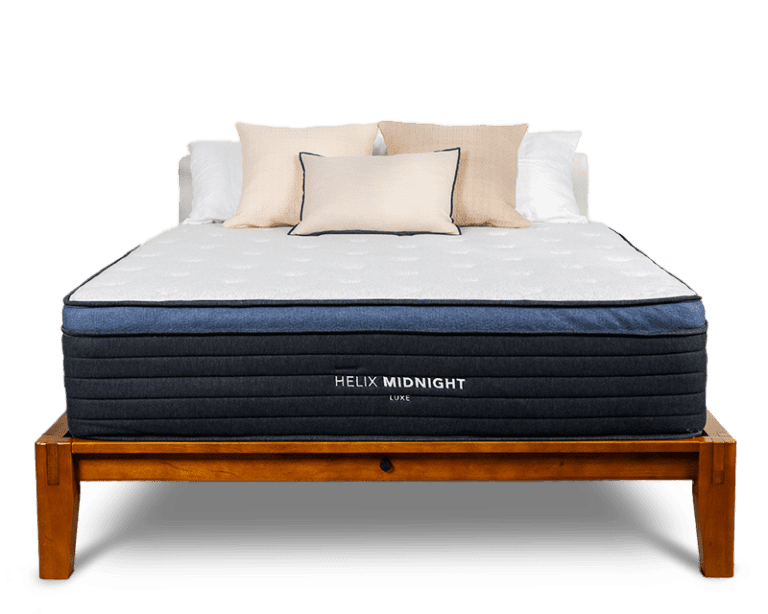
Helix Midnight Luxe
A premium quality, hybrid mattress created with side sleepers in mind.
Key Details
- Who It’s Best For: Hot sleepers, side and back sleepers in all weight categories and stomach sleepers between 130 and 230 pounds.
- Feel: Breathable and moisture-wicking cover that’s cool all night.
- What It’s Made Of: Pillow-top, two layers of memory foam, polyfoam transitional layer, conforming memory foam, and coil support core.
- What We Don’t Like: Not suitable for people with high heat sensitivity. Stomach and back sleepers weighing more than 230 pounds might not feel enough support.
Scoring & Reviews
The following ratings show how suitable this mattress is for different sleeping positions and sleeper weights. These scores are determined by how well the mattress supports and relieves pressure for each sleeper type.
In addition to the hands-on feedback from our team, we conduct a number of quantitative tests in our Test Lab. The below ratings are based on the experience of our testers.
SELECT AN ICON TO VIEW DETAILS:
Motion Isolation
As a medium firm mattress with thick foam comfort layers, it’s no surprise that the Midnight Luxe tested very well for motion isolation. Our testers could barely feel any movement across the surface of the mattress when fellow testers rolled around on it.
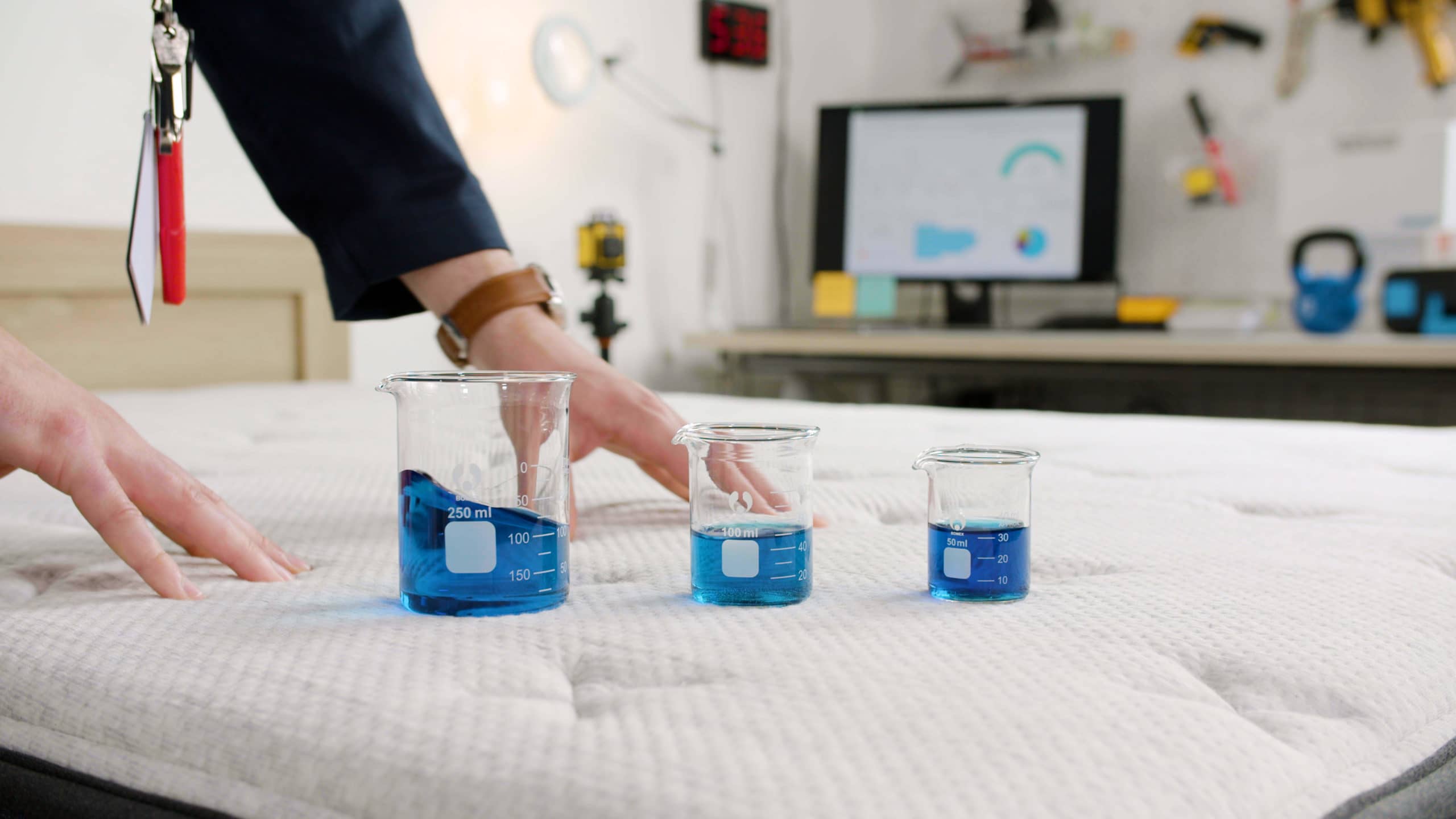
Pressure Relief
All of the Helix Luxe models have thick foam comfort layers and conform fairly close to the body. Consequently, they’ve all performed well in our pressure mapping tests, with notably less pressure in the hips and shoulders than many hybrids. With it’s 6 out of 10 firmness, The Midnight Luxe in particular performs average among other Helix Luxe beds.
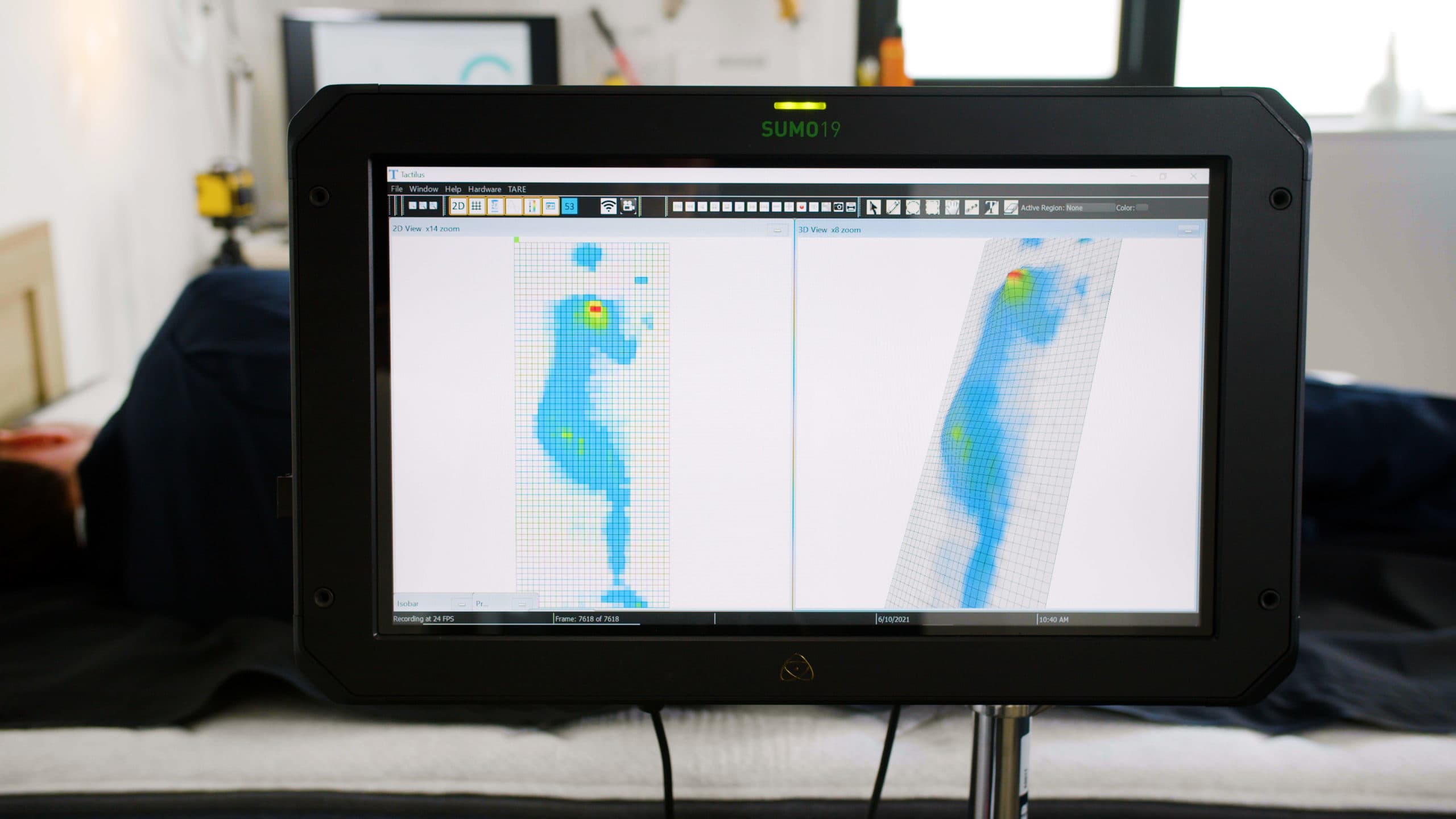
Temperature Control
The Helix mattresses perform about average for hybrids when it comes to sleeping cool. Memory foam is well-known for its tendency to sleep hot, as it often traps and retains heat through the night, but the coil cores of these beds promote airflow to help balance out heat retention.
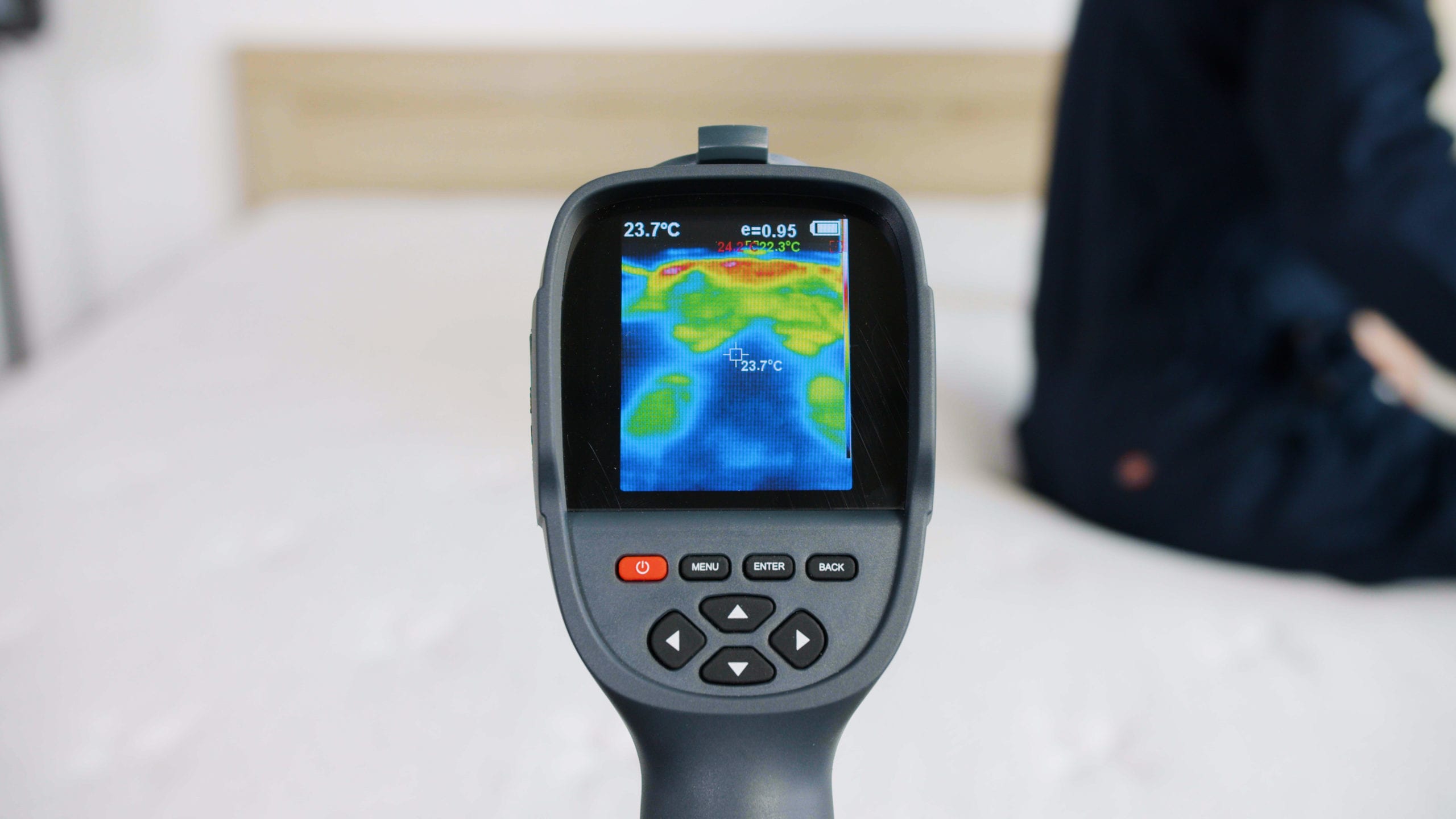
Edge Support
All Helix mattresses feature a reinforced perimeter, meaning the coils on the edges are thicker than the coils in the middle of the bed. When putting this to the test, we found significantly less sinkage on the edge than the middle while applying weight.
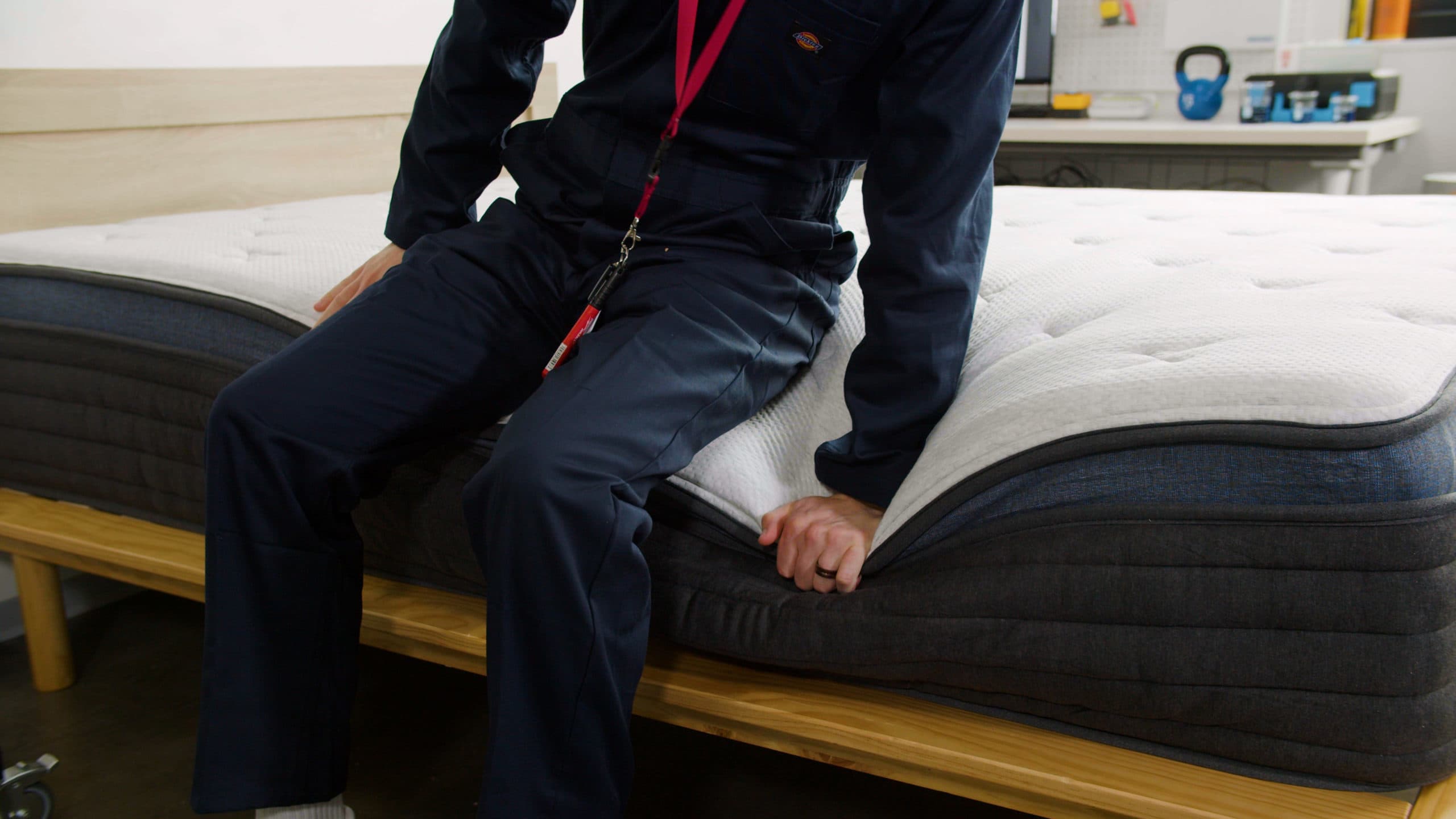
Ease of Movement
Helix Luxe mattresses tend to be somewhat responsive and bouncy, and all tested pretty well for ease of movement. The Midnight Luxe in particular had a middle-of-the-road performance in our tests, as the medium firm surface conforms a bit to the body, but doesn’t fully provide that ‘stuck’ feeling and inhibit motion.
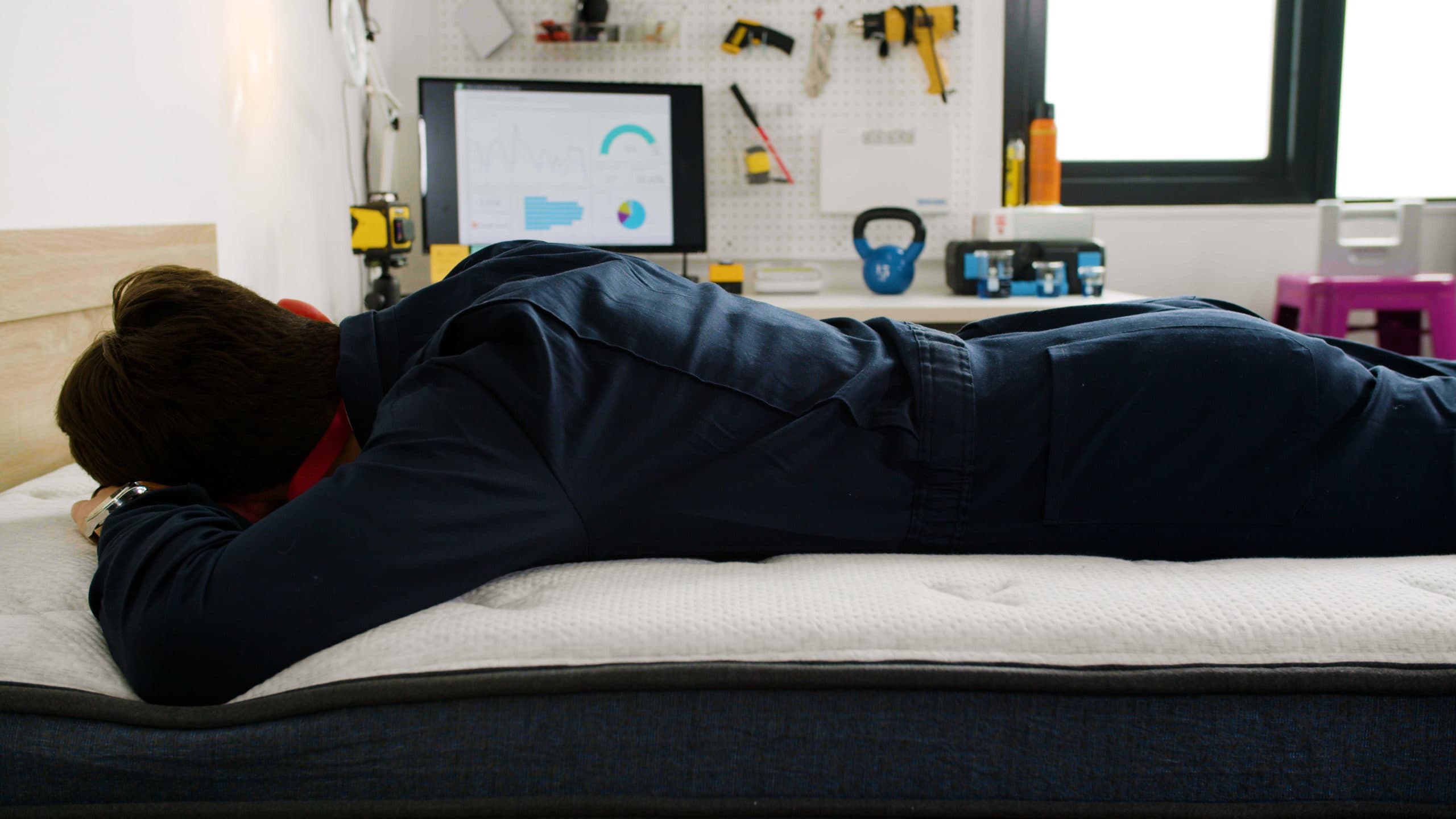
Durability
The Helix Luxe collection of hybrid mattresses is built for durability, and the firmer options will likely extend the life even further. Each model is 14 inches thick and features three layers of foam (memory and poly), plus has 1,000 individually wrapped coils, including zone and perimeter support. It’s likely that you’ll be able to enjoy this mattress for close to a decade.
Full Breakdown
The Helix Midnight Luxe is a foam hybrid model that offers a balance of conforming and support. We found that the medium-firm (6) feel appeals to a wide range of sleepers across body types and sleep positions.
How It Performed
Thanks to the responsive pocketed coils, pillow-top design, and thick foam comfort system, the Midnight Luxe performed well during our motion isolation tests, preventing too much movement from rippling across the surface. Our testing showed that the mattress also sleeps cool, due in part to the strong airflow through the coils. We recommend the mattress for most sleepers up to 230 pounds, though we observed that side sleepers between 130 and 230 pounds benefit the most from the bed’s balance of pressure relief and support.
Construction Breakdown
The Midnight Luxe has a quilted pillow-top design, beginning with polyfoam and gel-infused memory foam layers that contour closely to the body to relieve pressure points. Beneath is a polyfoam transitional layer that prevents you from sinking too far into the bed. Next is a substantial pocketed coil support core, providing significant support and allowing for airflow throughout the mattress. The coil layer also provides extra support in the lumbar area as well as along the bed’s perimeter.
For the cover, you may choose between a breathable Tencel cover or a GlacioTex Cooling cover, which is a fabric that keeps the surface cool using phase change technology. Note that the latter carries an additional cost.
Trial, Shipping, and Warranty
Helix ships free to the contiguous U.S. Plus, they offer a 120-night sleep trial and a lifetime warranty.
Read Our Full Helix Midnight Luxe ReviewBest Value Mattress
8.6 /10 Test Lab Score
Brooklyn Bedding CopperFlex Memory Foam
Hugs and soothes pressure points for restful sleep.
Key Details
- Who It’s Best For: Side sleepers weighing at least 130 pounds, back sleepers up to 230 pounds, and combination sleepers who weigh 130 to 230 pounds.
- Feel: Medium firm (6) with plush cushioning but gentle pushback, extra support beneath your torso and hips, fairly cool surface.
- What It’s Made Of: Top layer of adaptive polyfoam, two memory foam layers, zoned transitional polyfoam, two high-density foam base layers, cover made of GlacioTex, a proprietary fabric that draws heat away from the body.
- What We Don’t Like: Produces some strong off-gassing odor after unboxing that may linger up to 72 hours. Possibly too soft for back and stomach sleepers who weigh more than 230 pounds.
Scoring & Reviews
The following ratings show how suitable this mattress is for different sleeping positions and sleeper weights. These scores are determined by how well the mattress supports and relieves pressure for each sleeper type.
In addition to the hands-on feedback from our team, we conduct a number of quantitative tests in our Test Lab. The below ratings are based on the experience of our testers.
SELECT AN ICON TO VIEW DETAILS:
Motion Isolation
The CopperFlex Memory Foam provides great motion isolation, with our testers clocking almost no motion transfer across the bed during movement. This is due to the all-foam construction—with memory foam comfort layers and an all-foam base, there is little means for one side of the bed to affect the other.
Pressure Relief
This bed provides excellent pressure relief, which notably reduced pressure on the shoulders and hips compared to other beds. With a thick foam comfort layer and a foam base, the bed conforms close to the body and ‘hugs’ the sleeper quite a bit.
Temperature Control
As an all-foam bed, the CopperFlex is inevitable going to trap a decent amount of body heat. Luckily, the top layer of quilted polyfoam isn’t very dense, allowing for some airflow. We don’t find copper-infused foam to make too much of a difference in cooling.
Edge Support
Like most all-foam beds, the edge support of the CopperFlex memory foam is mediocre. The high density support core provides a bit of support, but there’s definitely some noticeable sinkage when sitting around the edges. Perhaps not the best choice for those with mobility issues.
Ease of Movement
As an all foam bed with a memory foam comfort layer, it’s no surprise that our testers found the CopperFlex Memory Foam a bit hard to move around on. The foam conforms close to the body, giving you that sinking sensation, and it definitely requires a bit more effort to roll around on the bed, especially for heavier sleepers.
Durability
Full Breakdown
The Brooklyn Bedding CopperFlex Memory Foam checks a lot of boxes for people with acid reflux. Supportive foam layers prevent most people from sinking too deeply into the mattress, allowing their heads to remain properly elevated, and cooling components in the cover and comfort system minimize heat buildup on the surface. As an all-foam mattress, the CopperFlex is also a solid match for an adjustable bed.
How It Performs
Most of our testing team gave high marks to the CopperFlex, with side sleepers of at least 130 pounds and back sleepers up to 230 pounds awarding the mattress its most favorable ratings. Stomach sleepers under 130 pounds should also find the CopperFlex comfortable and sufficiently supportive, whereas back and stomach sleepers over 230 pounds may need a firmer mattress.
We were greatly impressed with the CopperFlex during our tests for motion isolation and pressure relief. Both can be attributed to the bed’s all-foam construction with plush layers in the comfort system, which absorb movement and cradle the body to reduce pressure buildup. Our team also found the mattress sleeps cool — some heat retention may occur, but the CopperFlex outperforms most competing foam models.
Construction Breakdown
The CopperFlex contains six individual layers, beginning with a thin strip of adaptive polyfoam quilted to the cover. Two memory foam layers give the comfort system a cushy, adaptive feel, and a copper fiber infusion helps the mattress stay cool. The transitional foam is divided into three firmness zones to feel firmer and more supportive beneath your torso and hips. A support core consisting of two high-density polyfoam layers provides great overall stability, and the cover is made of GlacioTex fabric that’s designed to dissipate body heat on contact.
Trial, Shipping, and Warranty
Customers in the contiguous U.S. enjoy free ground shipping. Brooklyn Bedding’s sleep trial lasts 120 nights but includes a 30-night break-in requirement before returns can be initiated. If you choose to keep the mattress, it’s backed by a lifetime manufacturer’s warranty.
Read Our Full Brooklyn Bedding CopperFlex Memory Foam ReviewBest Mattress for Back Pain
9.4 /10 Test Lab Score
WinkBed
High end hybrid bed providing ample support, cushion, and cool sleep.
Key Details
- Who It’s Best For: Most body types and sleeping positions, particularly people with back pain.
- Feel: Responsive give and take and plushness in the top layers for balanced support and comfort for your back, hips, and shoulders.
- What It’s Made Of: Zoned pocketed coils with thicker springs around the edge, and adaptive polyfoam surface layer, followed by a layer of denser foam. Plus models feature zoned latex to prevent excess sinking.
- What We Don’t Like: May be too firm for some sleepers with back pain. Thicker and heavier, and thus potentially difficult to move and to find sheets to fit.
Scoring & Reviews
The following ratings show how suitable this mattress is for different sleeping positions and sleeper weights. These scores are determined by how well the mattress supports and relieves pressure for each sleeper type.
In addition to the hands-on feedback from our team, we conduct a number of quantitative tests in our Test Lab. The below ratings are based on the experience of our testers.
SELECT AN ICON TO VIEW DETAILS:
Motion Isolation
All four firmness options offer above-average motion isolation compared to other hybrids we’ve tested. The Softer, Luxury Firm, and Firmer models have polyfoam layers that significantly absorb vibrations, preventing motion from traveling across the surface. The Plus features latex, and does not isolate as much motion – though it still received high marks from our team. Although the coil core gives the mattress some bounce, the foam layers are substantial enough to dampen motion transfer.
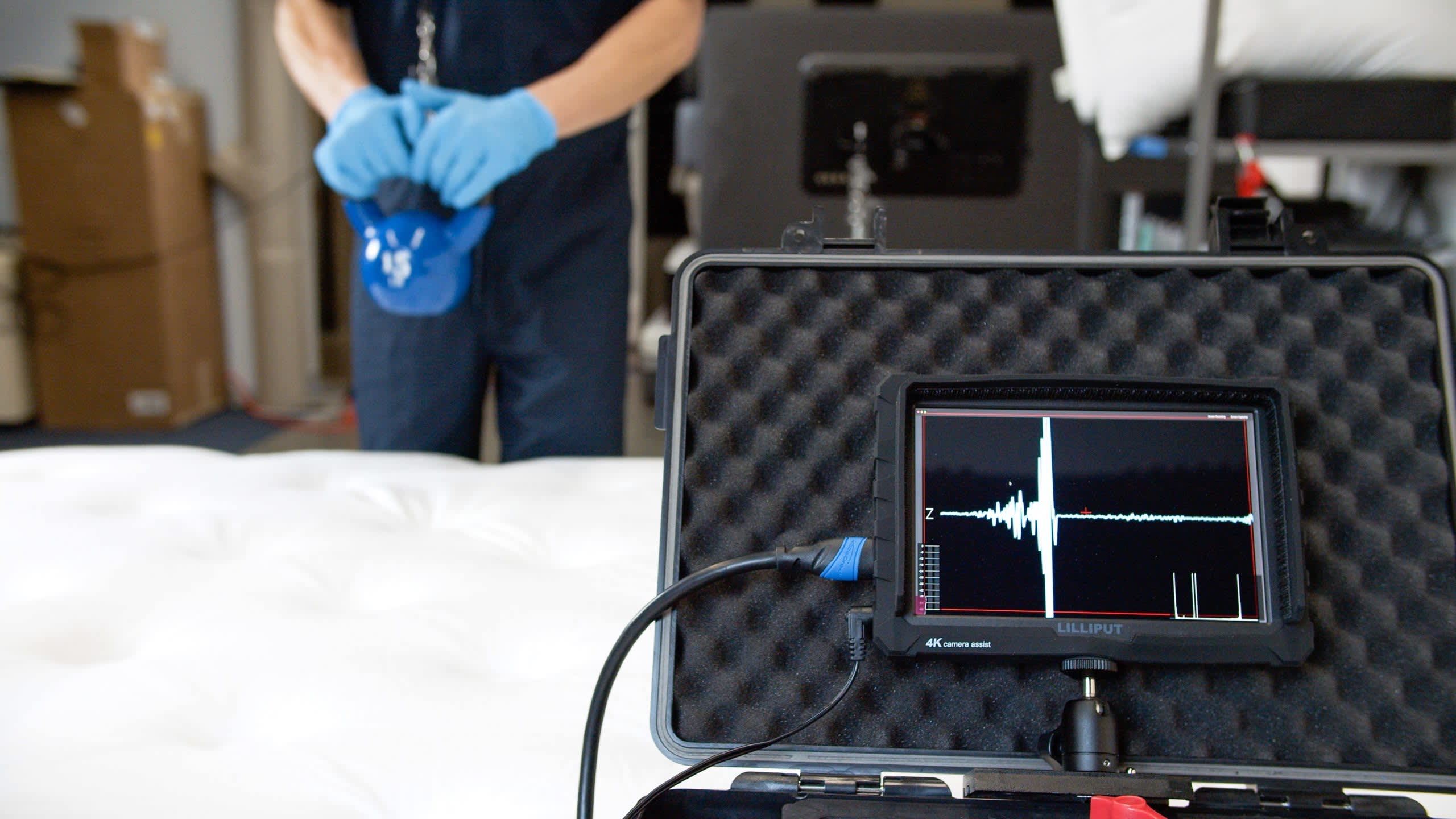
Pressure Relief
Like with many hybrid models, the WinkBed’s strong contouring can help relieve painful pressure points. Using pressure-mapping sensors, we found the Softer, Luxury Firm, and Firmer versions of the mattress generously cradle your body and ease pressure off sensitive joints, thanks largely to the multiple foam layers. The Plus version uses polyfoam and latex layers, which offer gentle contouring as well.
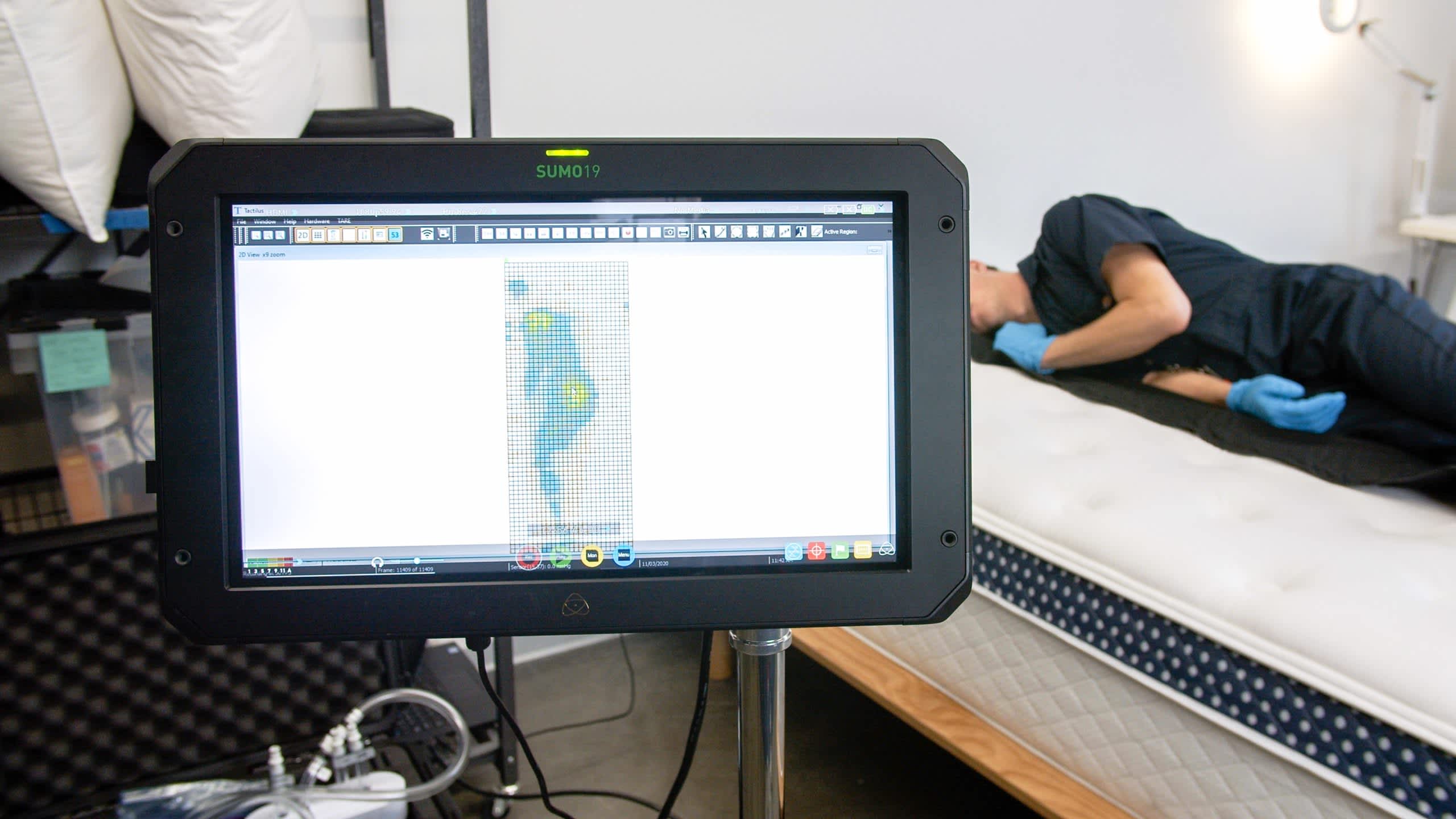
Temperature Control
The WinkBed’s Tencel cover wicks heat and moisture away from the sleeper’s body. In the Softer, Luxury Firm, and Firmer models, polyfoam infused with cooling gel helps to minimize heat retention. The Plus version uses latex, a naturally breathable material that resists heat buildup.The coil core also promotes significant air circulation. All of these components make the WinkBed one of the best cooling mattresses on the market.
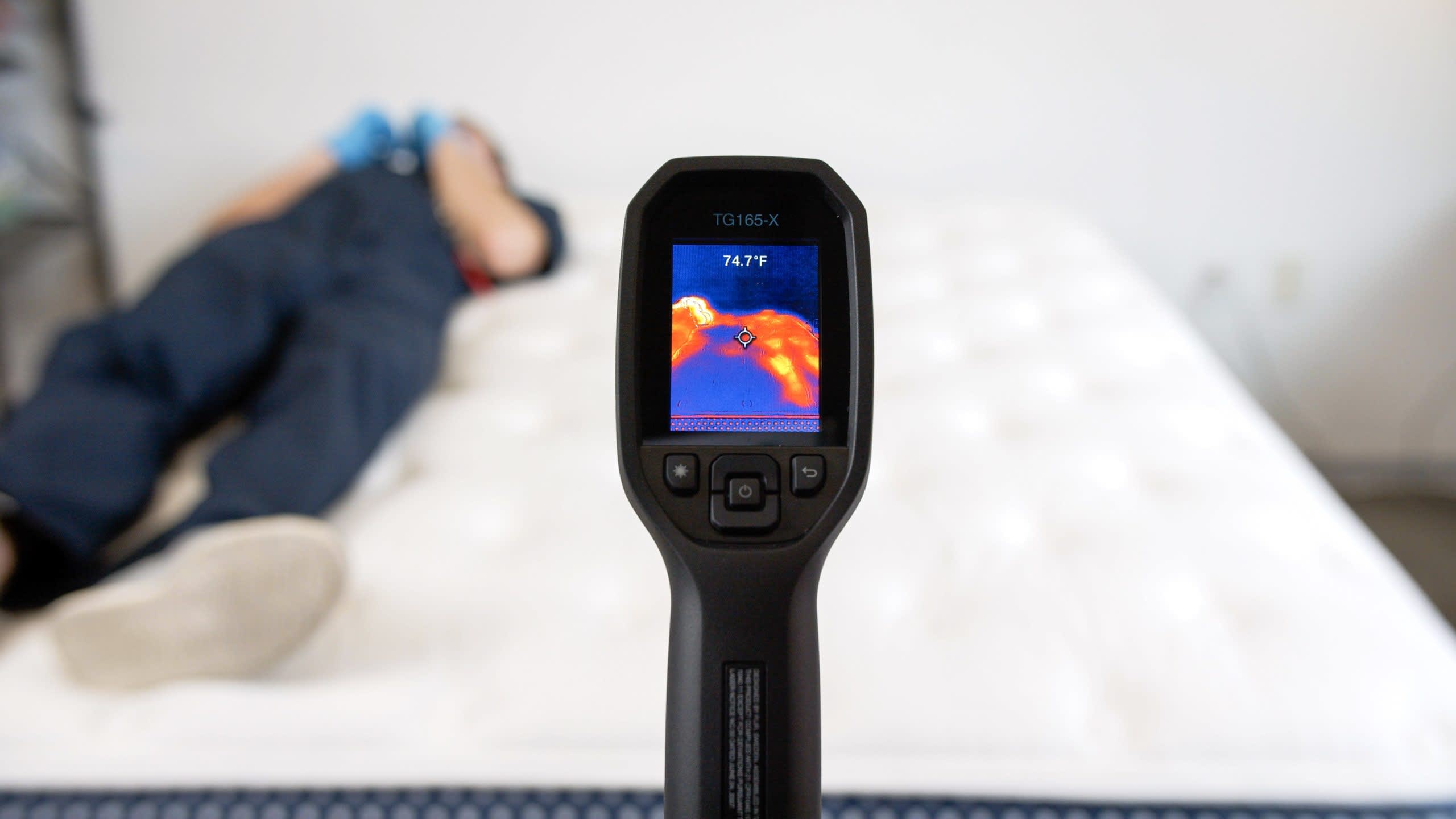
Edge Support
While many hybrid models have sturdy edges, the WinkBed’s perimeter is exceptionally strong . Thanks to extra reinforcement along the edges, our testers noticed minimal compression when sitting along the edge. Most sleepers should feel secure enough to sleep or sit on the full surface of the mattress without worrying about rolling off.The edge of the Softer model may not seem quite as sturdy as the Luxury Firm, Firmer, and Plus versions, due to its plusher design.
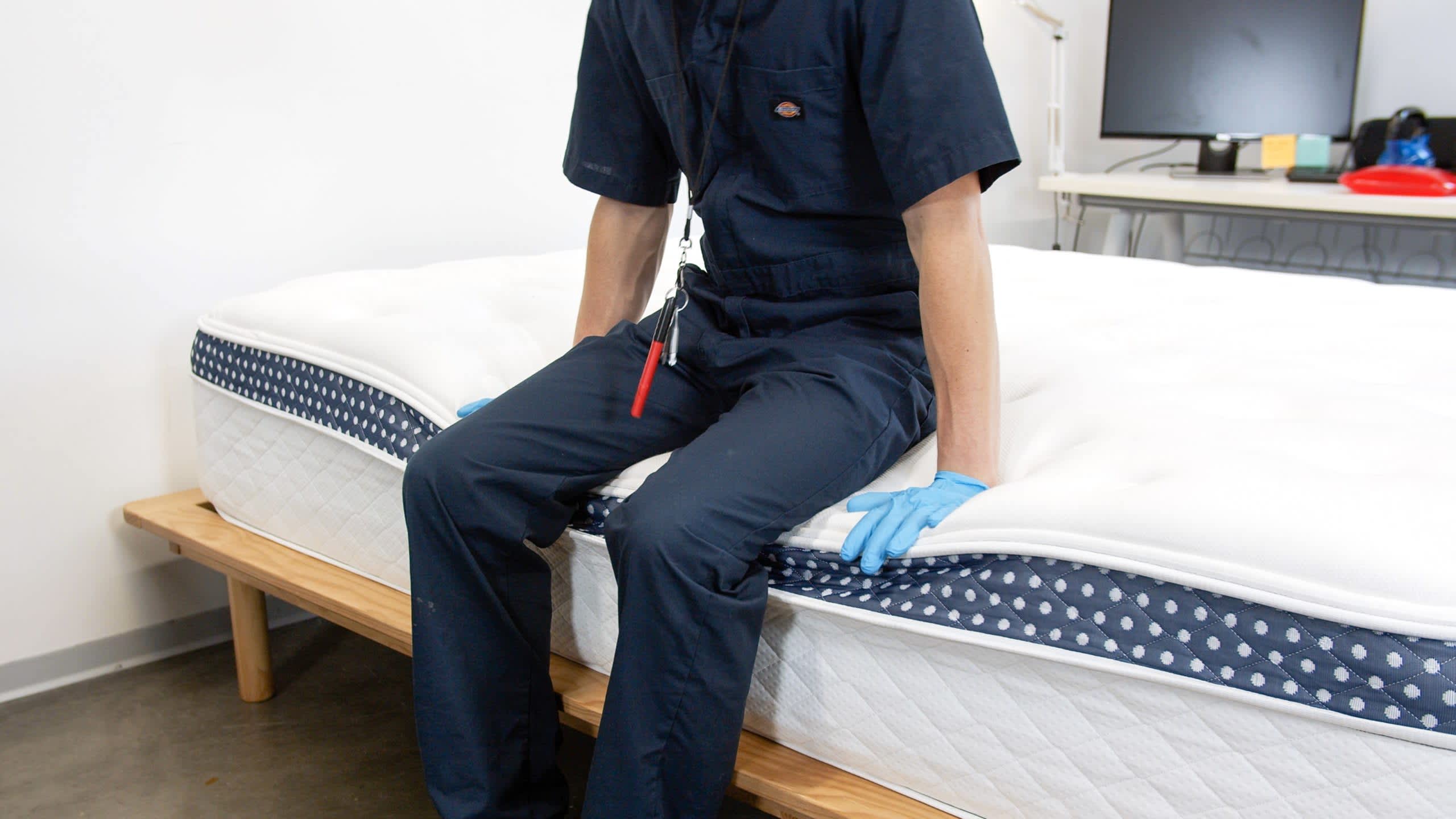
Ease of Movement
The three softest versions of the WinkBed Mattress feature polyfoam comfort layers. Polyfoam is more responsive than memory foam, so the WinkBed won’t hug your body as closely as hybrid mattresses made with close-conforming memory foam. The result is strong ease of movement across the surface.The Plus model features a very responsive latex layer, so this option shines when it comes to ease of movement.
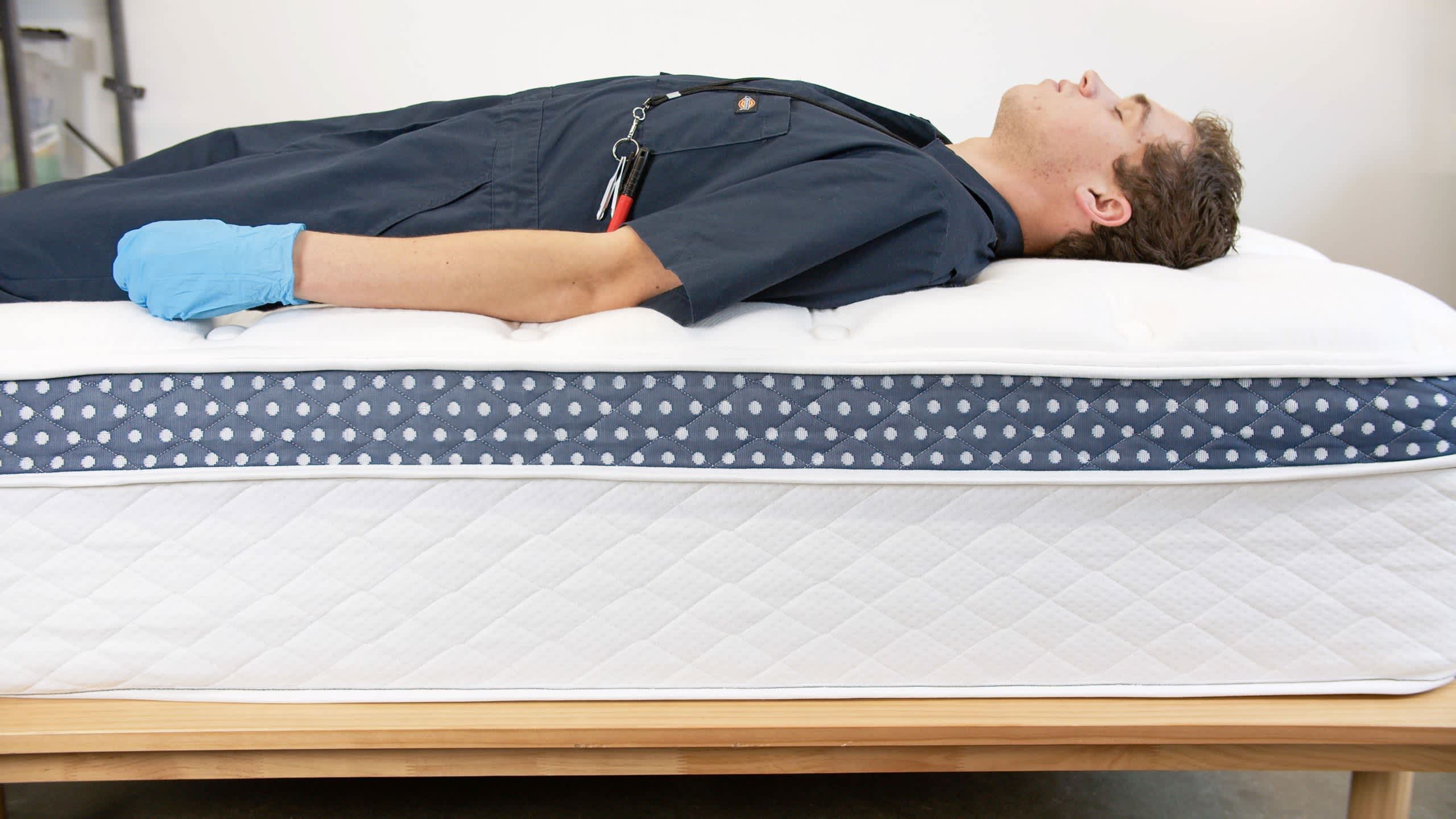
Durability
As a hybrid mattress with a polyfoam comfort layer, the Winkbed should last slightly longer than the average bed. Hybrids tend to be durable because the inner coils last a long time, and polyfoam is more durable than memory foam. That being said, the foam comfort layer isn’t too thick on the Winkbed (2 to 2.5 inches, depending on the firmness you choose), so you might find the bed getting less comfortable after around eight or nine years when impressions and sagging start to set in.
Full Breakdown
The WinkBed is a foam hybrid designed to cushion the body without sacrificing support. Available in four firmness levels, the mattress should be comfortable regardless of your body type or primary sleep position. The adaptive foam layers can also reduce soreness and pressure points if you experience back pain at night.
How It Performed
After testing each firmness level for the WinkBed, we noticed specific strengths for all four options. The medium soft (4) model contoured closely to distribute our testers’ weight and alleviated pressure along the spine. This design was most popular among our side and back sleepers weighing less than 130 pounds. If you want a more balanced feel, you should consider the medium-firm (6) feel, which provides light conforming and excellent overall support. Our back and stomach sleepers weighing at least 130 pounds and side sleepers weighing more than 230 pounds awarded the most favorable ratings to this design.
The firm (7) and Plus (8) models should provide adequate reinforcement if you weigh more than 230 pounds, regardless of your sleep position. These versions of the WinkBed also earned excellent ratings for edge support, and none of us had trouble moving across their surfaces. Another area where the WinkBed performed well is temperature control, due to its cooling Tencel cover and steady air circulation through the coils.
Construction Breakdown
Standard WinkBed models are available in medium-soft, medium-firm, and firm designs. These mattresses feature adaptive polyfoam quilted into their covers, followed by polyfoam comfort layers. The WinkBed Plus is constructed with responsive latex instead of a second foam layer. As a result, the Plus felt bouncier and more supportive than the other three models.
All WinkBeds contain pocketed coil support cores. This layer is divided into different zones based on coil gauge, or thickness, creating more pushback beneath your torso and hips and gentler cradling for lighter areas of your body. A cover made of breathable, moisture-wicking Tencel fabric encases the mattress.
Trial, Shipping, and Warranty
WinkBeds offers free ground shipping throughout the contiguous U.S. Each mattress comes with a sleep trial of up to 120 nights. If you’re unsatisfied with your initial firmness selection, you may exchange the original mattress for a new model at no extra cost. The replacement model is also backed by a 60-night trial. WinkBeds provides a lifetime warranty to all buyers.
Read Our Full WinkBed ReviewBest Mattress for Side Sleepers
9.0 /10 Test Lab Score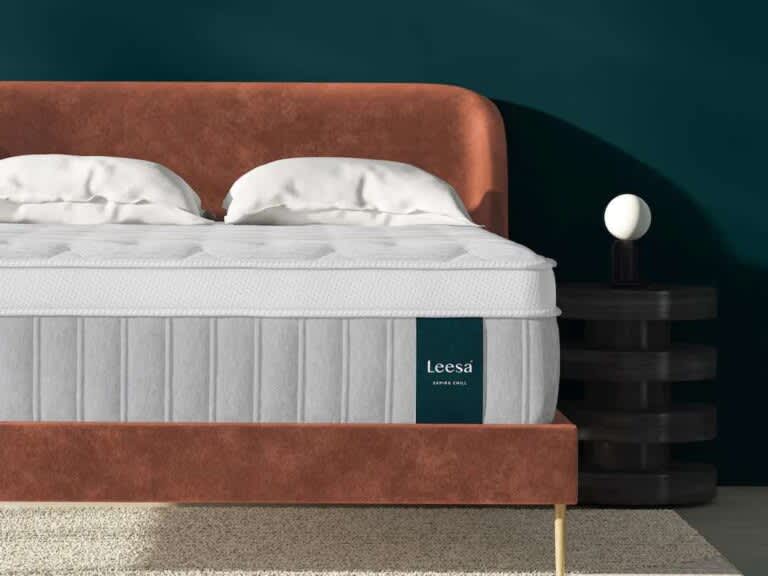
Leesa Sapira Chill Hybrid
A foam hybrid that cushions your body without trapping heat.
Key Details
- Who It’s Best For: Most sleepers, depending on firmness.
- Feel: Bounce on the surface, as well as pressure relief. Reinforcement beneath your midsection, though pushback around torso and hips depends on firmness level.
- What It’s Made Of: Top layer of gel-infused polyfoam quilted to the cover, a second polyfoam comfort layer, transitional memory foam, pocketed coils divided into different zones, and high-density base foam.
- What We Don’t Like: Strong initial off-gassing odor up to 72 hours after unboxing. Weaker edge support for the medium (5) design and less motion isolation from the medium-firm (6) and firm (7) models.
Scoring & Reviews
The following ratings show how suitable this mattress is for different sleeping positions and sleeper weights. These scores are determined by how well the mattress supports and relieves pressure for each sleeper type.
In addition to the hands-on feedback from our team, we conduct a number of quantitative tests in our Test Lab. The below ratings are based on the experience of our testers.
SELECT AN ICON TO VIEW DETAILS:
Motion Isolation
In our tests, the Sapira Chill Hybrid’s foam-heavy comfort system absorbed most motion with ease. Even when one tester shifted positions or got up, the other hardly noticed — especially on the medium and medium firm models. For couples, this mattress is a standout in motion isolation for a hybrid.
Pressure Relief
Pressure relief was a top-scoring category across the board. Our side sleepers noted significant cushioning in the hips and shoulders, and even our back sleepers experienced a nice balance of support and contouring. The plush top layers adapted closely without making us feel stuck.
Temperature Control
Though it contains multiple foam layers, the Sapira Chill didn’t trap as much heat as we expected. The open-cell construction and airflow from the coil core helped maintain a neutral sleep temperature for most of our testers — particularly on the firmer options where we didn’t sink in as deeply.
Edge Support
We were impressed with how well the Sapira Chill held up around the edges. The reinforced perimeter coils gave us a stable feel when sitting or lying near the sides of the bed, which is especially helpful for co-sleepers or anyone who likes to spread out.
Ease of Movement
Movement on the Sapira Chill felt smooth, especially for a hybrid with four foam layers. While the softer model had a bit of a “sink-in” feel, the underlying coil support and responsive transition foam made it easy to shift positions or get in and out of bed on all three firmness levels.
Durability
The Leesa Sapira Chill Hybrid earns high marks for durability. As a hybrid mattress that uses four distinct foam layers, two of which are high-density polyfoam, sleepers can rely on cradling support without sinkage. Add to that the pocketed coil layer with individually wrapped springs, and the mattress should provide at least eight years of comfort.
Full Breakdown
If you share the bed with a sleep partner who has different firmness preferences, consider a mattress that falls in the middle of the firmness spectrum, like the Leesa Sapira Hybrid. With a medium-firm (6) feel and thick foam layers over sturdy coils, this mattress should appeal to people across a range of sleep preferences and sleep positions.
How It Performed
During our tests, the Sapira Hybrid earned high marks from our side sleepers weighing at least 130 pounds and our back and stomach sleepers weighing less than 130 pounds. Side sleepers enjoy the close yet even contouring and pressure relief along the spine. Meanwhile, back and stomach sleepers can lie comfortably without sinking too deeply around the midsection.
Steady airflow through the comfort and support systems helped the Sapira Hybrid excel during our temperature control tests, as did the open-cell foam layers and breathable cover. The responsiveness should provide enough bounce for sex, but the foam layers absorbed a good deal of movement when we tested the mattress for motion isolation.
Construction Breakdown
The Sapira Chill Hybrid’s comfort system consists of gel-infused adaptive polyfoam, standard polyfoam, and transitional memory foam layers. How dense and supportive these materials feel depends on which firmness level you select, though all provide at least a little cushioning on the surface.
The pocketed coil support core is zoned to create extra pushback beneath your torso and hips. A base layer of high-density foam provides additional stability. A knit polyester cover bearing Leesa’s signature stripe pattern encases the mattress.
Trial, Shipping, and Warranty
Leesa offers free ground shipping to all 50 states. Your order comes with a 120-night sleep trial. If you opt to keep it, your purchase is covered under a lifetime warranty against workmanship defects.
Best Luxury Mattress
9.5 /10 Test Lab Score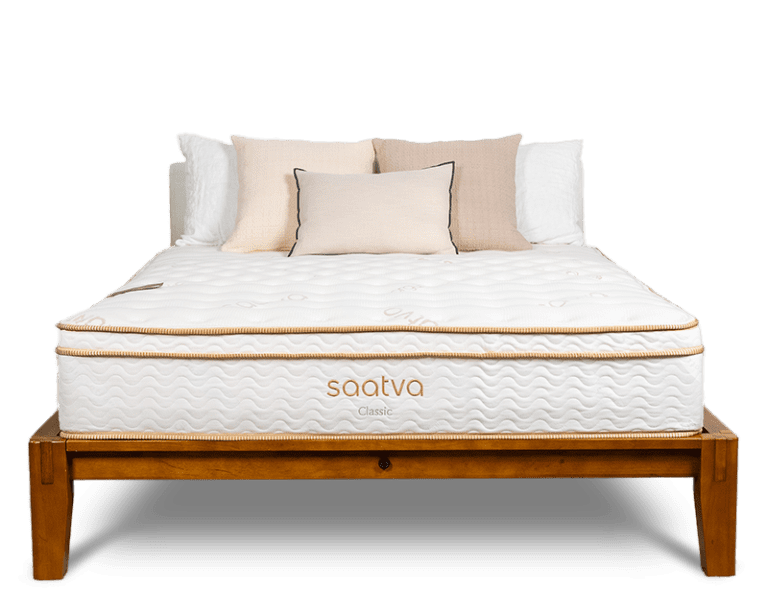
Saatva Classic
Traditional innerspring with a plush euro-top and excellent breathability.
Key Details
- Who It’s Best For: Almost any sleeper, depending on firmness level.
- Feel: Soft (3), luxury firm (6) or firm (8) model, all with cushioning comfort, moderate bounce, and solid edge support.
- What It’s Made Of: Polyfoam top layer supplemented by memory foam lumbar support, a layer of micro-coils, and a tall layer of innerspring coils for the support core.
- What We Don’t Like: Firmest model may be too firm for sleepers under 130 pounds, while the plush model may not be firm enough for people over 130 pounds. Return fee $99.
Scoring & Reviews
The following ratings show how suitable this mattress is for different sleeping positions and sleeper weights. These scores are determined by how well the mattress supports and relieves pressure for each sleeper type.
In addition to the hands-on feedback from our team, we conduct a number of quantitative tests in our Test Lab. The below ratings are based on the experience of our testers.
SELECT AN ICON TO VIEW DETAILS:
Motion Isolation
Motion isolation is one of the Saatva Classic’s weaker performance areas. The dual-coil design makes the surface responsive to movement, resulting in a noticeable bounce when you switch sleep positions or get in and out of bed. This can be problematic if you share your bed with a partner, as their movements can disrupt your sleep and vice versa.
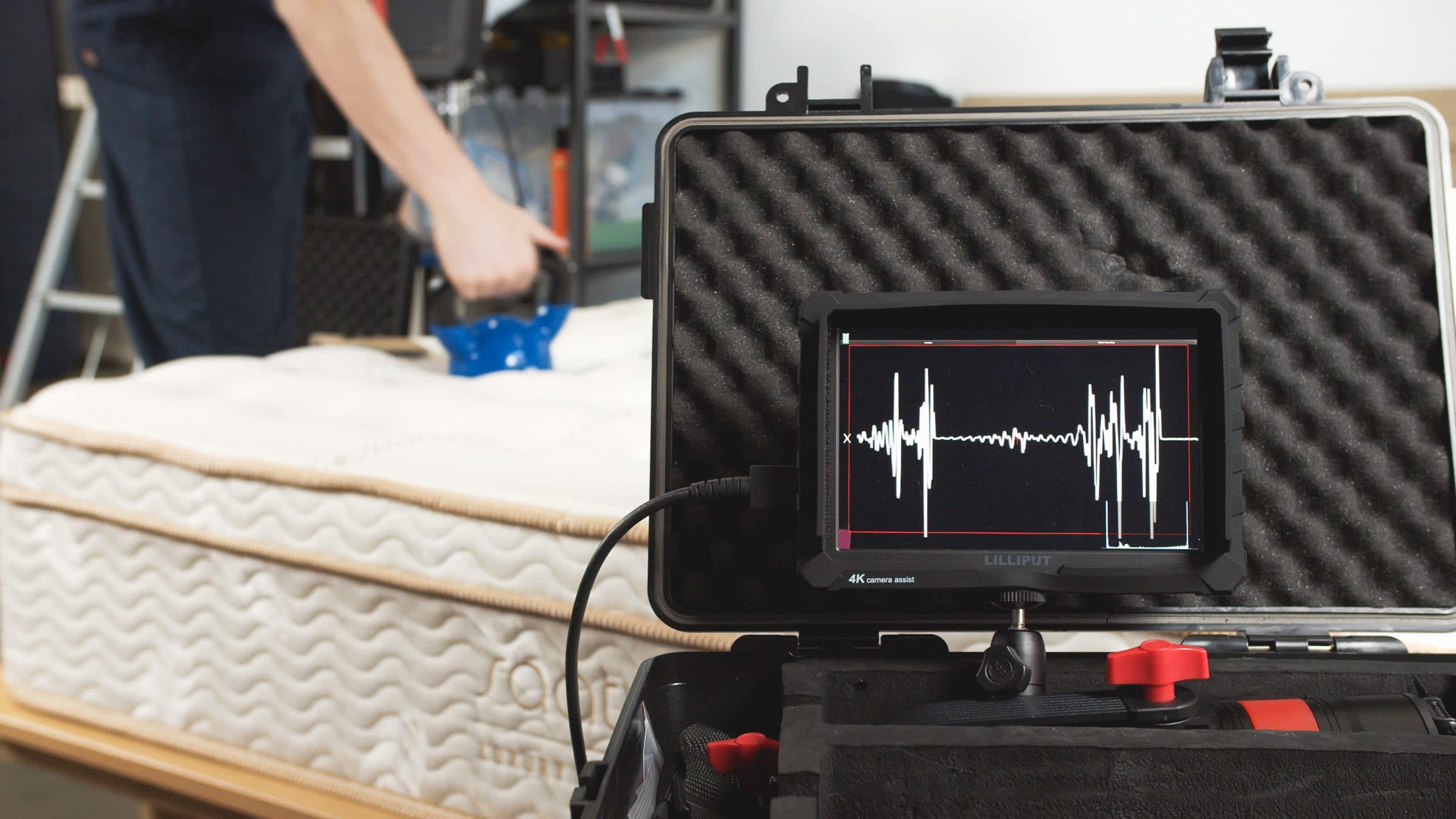
Pressure Relief
While all of the Saatva firmness options have pressure-relieving potential, the amount of pressure relief that an individual experiences on the mattress will vary based partially on their weight and sleep position. Individuals who weigh under 130 pounds will likely experience the most pressure relief on the Plush Soft version of the mattress, while sleepers over 230 pounds will likely get the best balance of contouring and support from the Firm version.
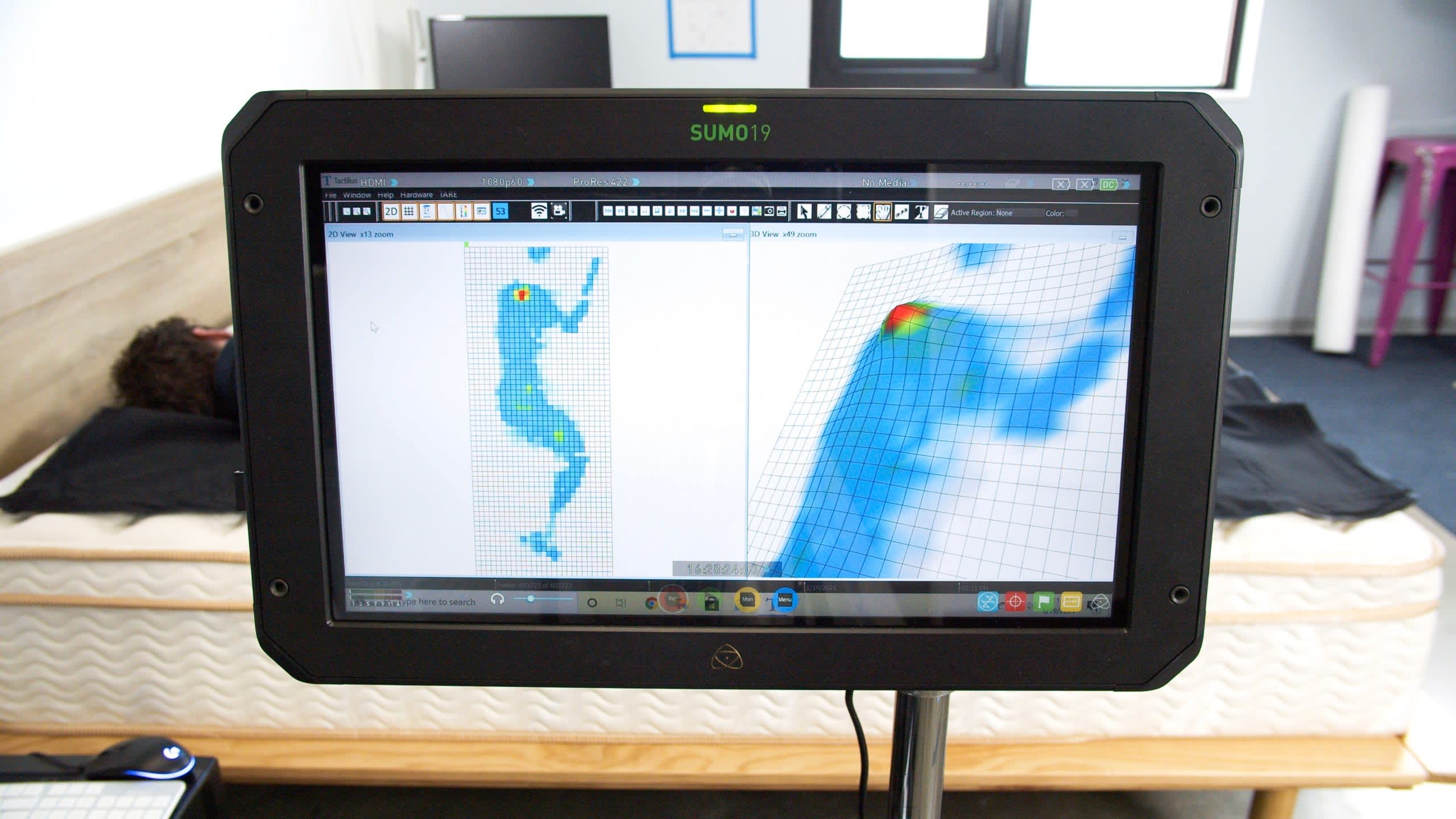
Temperature Control
While hybrid mattresses tend to sleep cool, the Saatva Classic’s construction may help it sleep even cooler than many other hybrid models. While all the firmness options may help promote a cooler night’s sleep, the Plush Soft version has more conforming that could lead to slightly more heat retention.
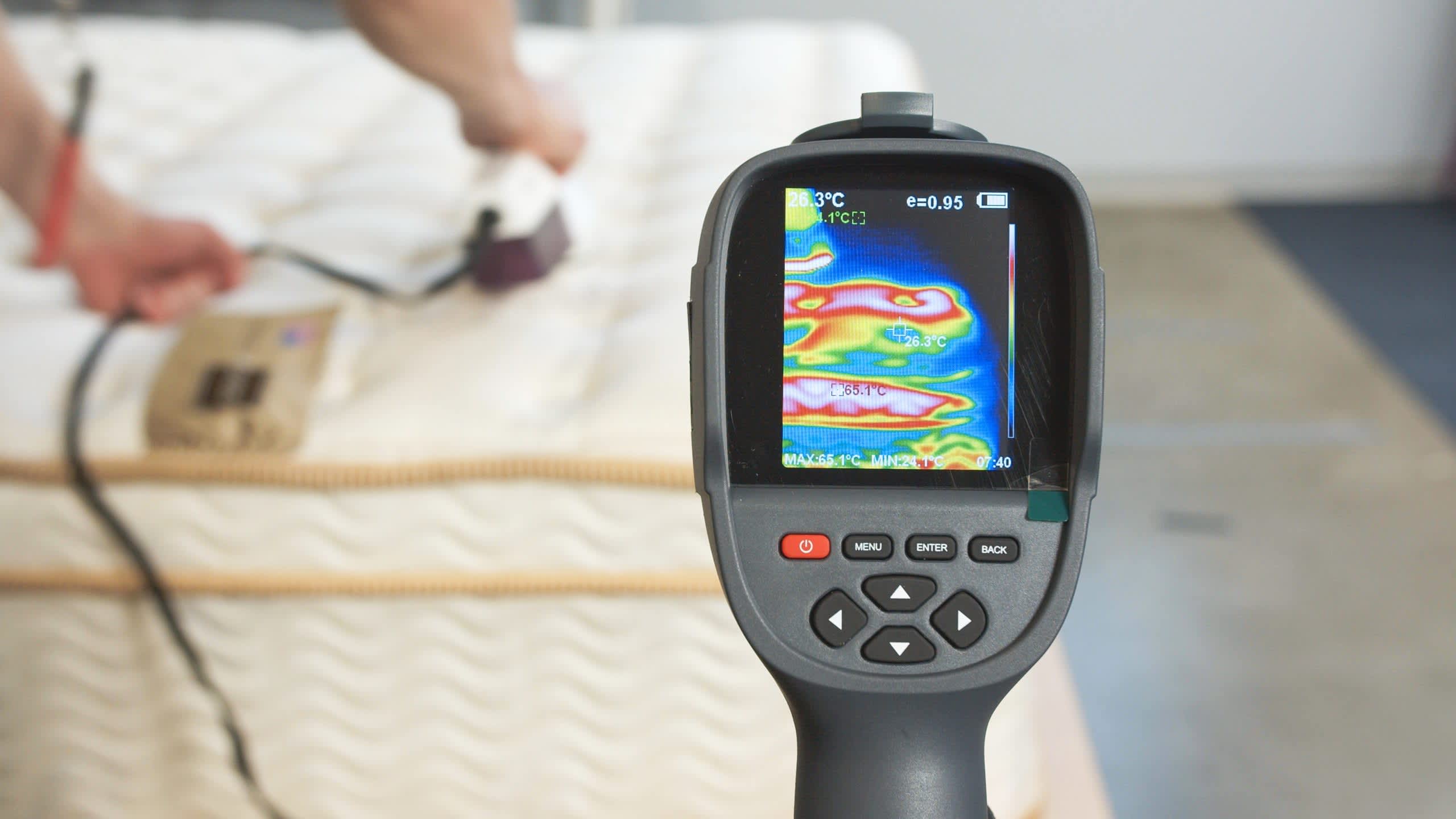
Edge Support
The Saatva Classic has a sturdy enough edge to allow almost all individuals to sit or sleep near the perimeter without excessive sinkage. This reinforcement is excellent even compared to most hybrid models.Because the Plush Soft version of the Saatva allows individuals to sink in more, its edges may not feel quite as secure as those of the Luxury Firm and Firm versions of the mattress.
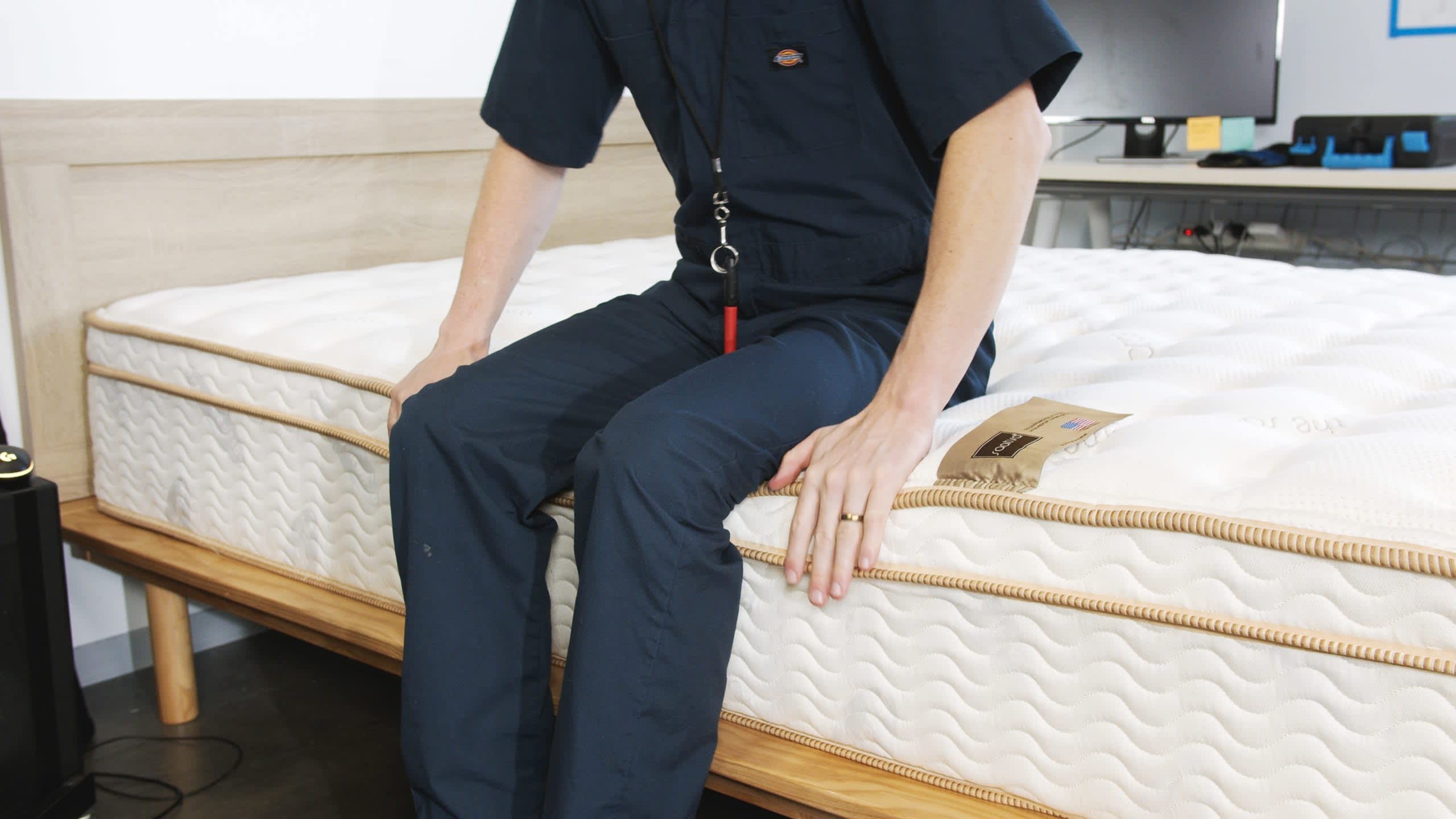
Ease of Movement
The Saatva Classic’s comfort system consists of polyfoam and minicoils. While these materials conform to your body, they regain their shape more quickly than memory foam. This prevents sleepers from feeling “trapped” in the bed.All three designs are relatively easy for sleepers to move across and change positions on. However, most individuals will probably find the firmer versions of the mattress easier to move on, since they conform less than the Plush Soft version.
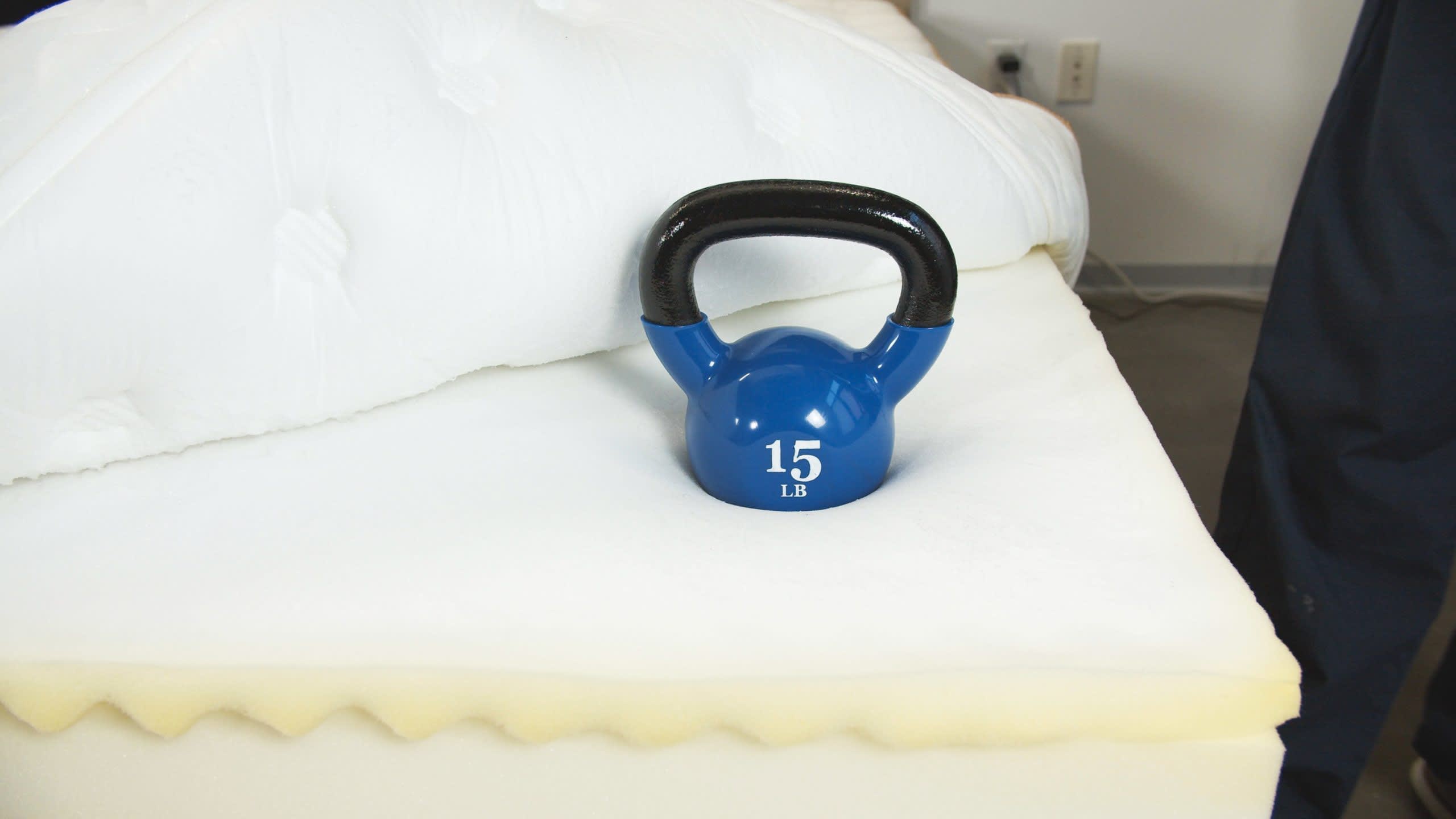
Durability
The Saatva Classic is stacked with features that help ensure durability. It’s constructed with both pocketed and support coils, plus polyfoam and memory foam comfort layers for additional comfort and support. Shoppers have a choice of thickness and firmness levels, and in general, going with thicker and firmer options can help add to the longevity. With its thick, 13-gauge coils in the bottom layer providing a sturdy base, this mattress should easily make it to the 10-year mark.
Full Breakdown
The Saatva Classic is a comfortable option for anyone who prefers the responsive, springy feel of classic innersprings but also wants some body contouring from their sleep surface. If you tend to sleep hot, the double layer of coils promotes strong airflow to help keep your bed cool at night.
How It Performed
You can choose between three firmness levels for your Classic: soft (3), medium firm (6), or firm (8). You can also choose between two thickness options. This wide range of options ensures most people can find a comfortable feel regardless of body type or general preferences.
During our tests, the deep cradling of the soft model felt most comfortable to testers who sleep on their side and weigh up to 130 pounds. The medium-firm model offered a balance of cushioning and support that earned high marks from our side and back sleepers between 130 and 230 pounds. The firm model felt most comfortable to testers who weigh over 230 pounds, as well as back and stomach sleepers above 130 pounds.
We found temperature control was one of the Classic’s biggest strengths, due to the breathable organic cotton cover and the dual coil design, which allows plenty of steady airflow through the mattress. As a result, we recommend the mattress for people who tend to sleep hot.
Construction Breakdown
The mattress features a Euro-top cushioned with polyfoam and memory foam, resulting in a plush feel on the surface. Beneath is a transitional layer composed of pocketed minicoils that respond to your body while also providing pushback to balance out the contouring foams above. A support core of sturdy hourglass coils made the Classic feel exceptionally stable during our performance tests, especially along the edges.
Trial, Shipping, and Warranty
Saatva is one of the only online mattress brands in the country to offer free White Glove delivery for all customers. This service includes full assembly in a room of your choice and removal of your old mattress. You’ll also receive a 365-night sleep trial and lifetime warranty with your purchase.
Best Mattress for Couples
9.2 /10 Test Lab Score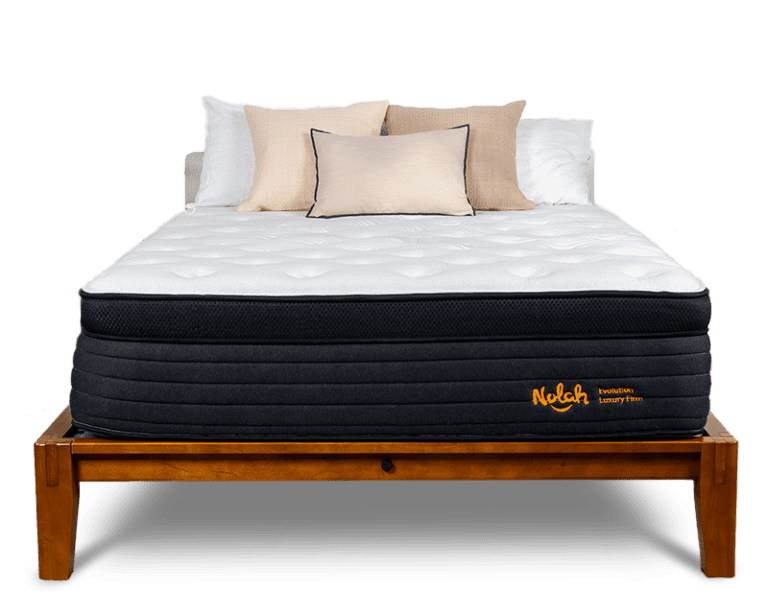
Nolah Evolution 15
A cloud-like experience with a plush euro-top in multiple firmnes options.
Key Details
- Who It’s Best For: Side sleepers with back pain and people who experience pressure buildup at night.
- Feel: Plush when sinking in but relatively easy to move around on the surface.
- What It’s Made Of:Euro-top cover quilted with foam, a proprietary AirFoam comfort layer (for cooling), followed by polyfoam for contouring. Support core of an 8-inch pocketed coil system.
- What We Don’t Like: Difficult to find sheets deep enough to accommodate thickness. Return fee of $99.
Scoring & Reviews
The following ratings show how suitable this mattress is for different sleeping positions and sleeper weights. These scores are determined by how well the mattress supports and relieves pressure for each sleeper type.
In addition to the hands-on feedback from our team, we conduct a number of quantitative tests in our Test Lab. The below ratings are based on the experience of our testers.
SELECT AN ICON TO VIEW DETAILS:
Motion Isolation
Thanks to its thick polyfoam layers, the Nolah Evolution 15 Hybrid absorbs enough movement to prevent most sleep disruptions. However, there is still some motion transfer because of the bounciness of the coils. You can expect the most motion transfer on the firm (8) model and the least on the plush (5) option. Across the board, though, our testers noticed only light motion transfer across all three firmness levels.
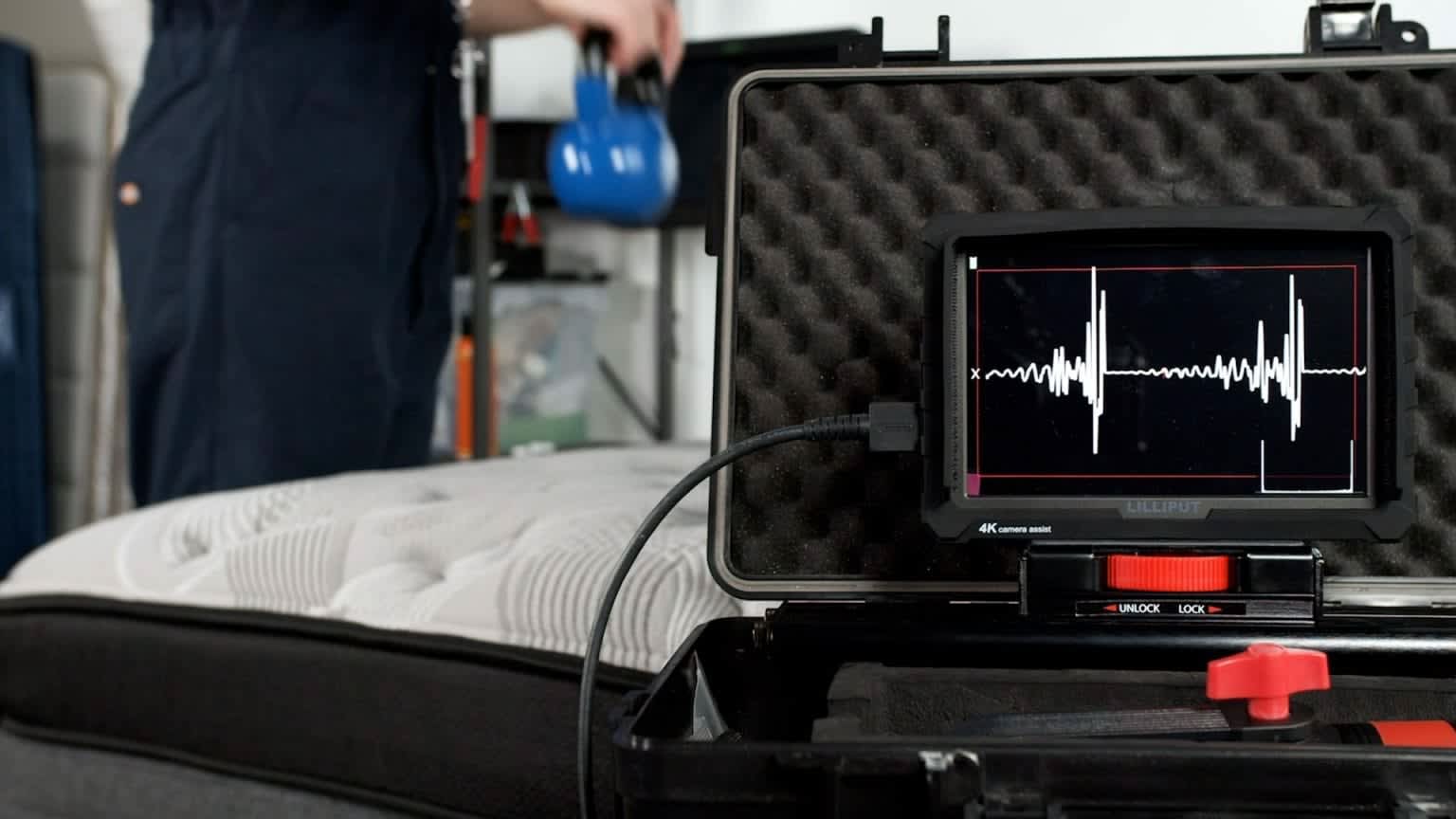
Pressure Relief
The combination of zoned coils and multiple polyfoam layers, including zoned AirFoam, enable the Nolah Evolution Hybrid to cushion pain points and provide above-average pressure relief. Choosing the right firmness option can optimize pressure relief. While individual preferences vary, a plush (5) or luxury firm (6) model works best for most side sleepers under 230 pounds, while the luxury firm (6) or firm (8) are better suited to the majority of back and stomach sleepers.

Temperature Control
Like many hybrids, the Nolah Evolution 15 excels at temperature regulation. Cooling fibers in the cover are engineered to draw heat away from the body, and the aerated polyfoam layers help reduce heat retention. The coil layer also promotes steady ventilation.In our testing, all three models resisted heat retention. That said, compared to the firm (8) model, the plush (5) and luxury firm (6) permit more sink and allow slightly less cooling airflow around the skin.
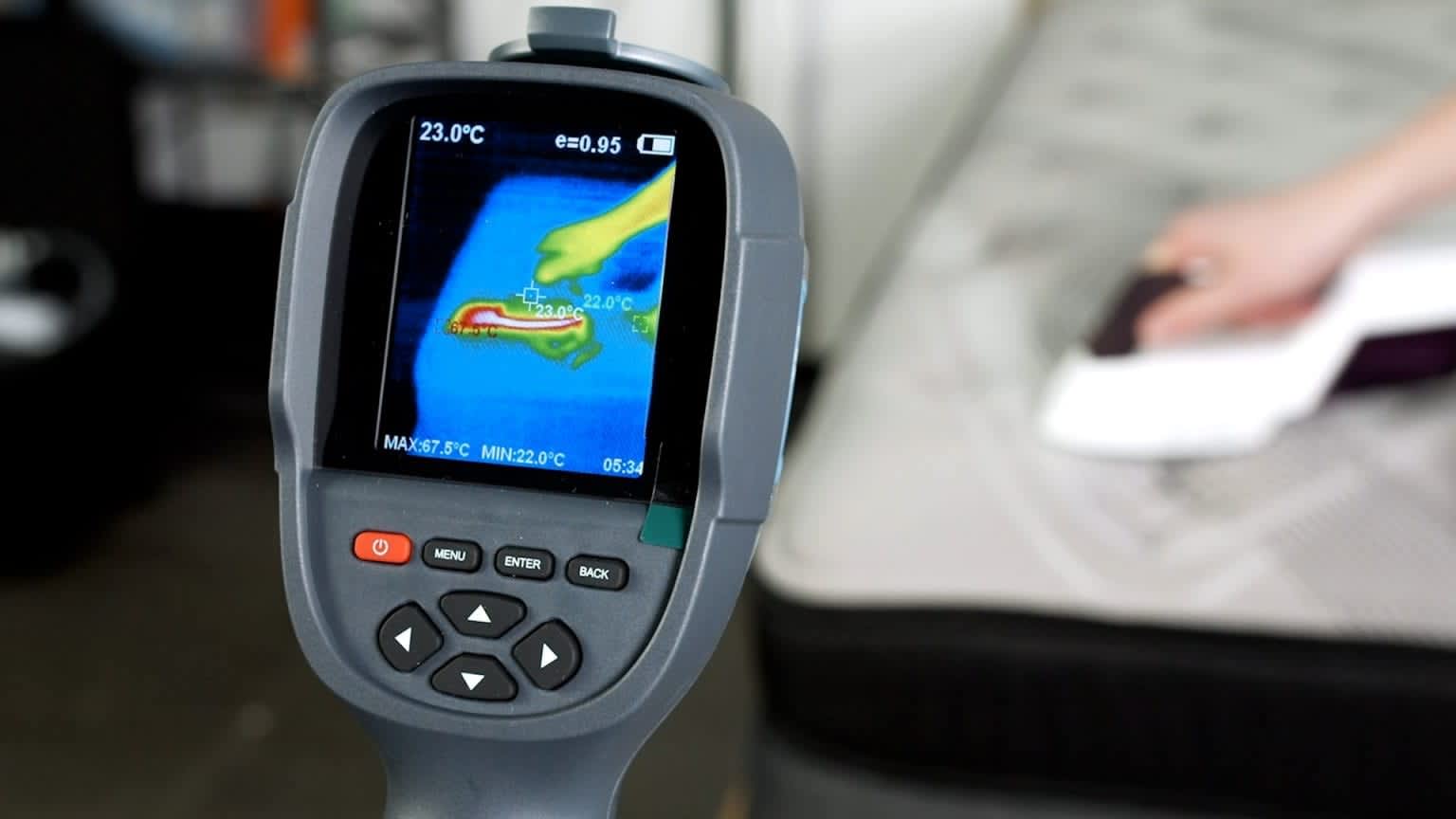
Edge Support
The sturdy 8-inch coils gives the Nolah Evolution Hybrid a reliable level of edge support. While there can be some sink from the foam layers, resilient polyfoam prevents instability around the perimeter of the bed.Edge support does vary based on the firmness level. Our team noticed a reduction in edge support between the firm (8) and the luxury firm (6) and plush (5) models. Even on the softer models, though, you get solid edge support from this mattress.
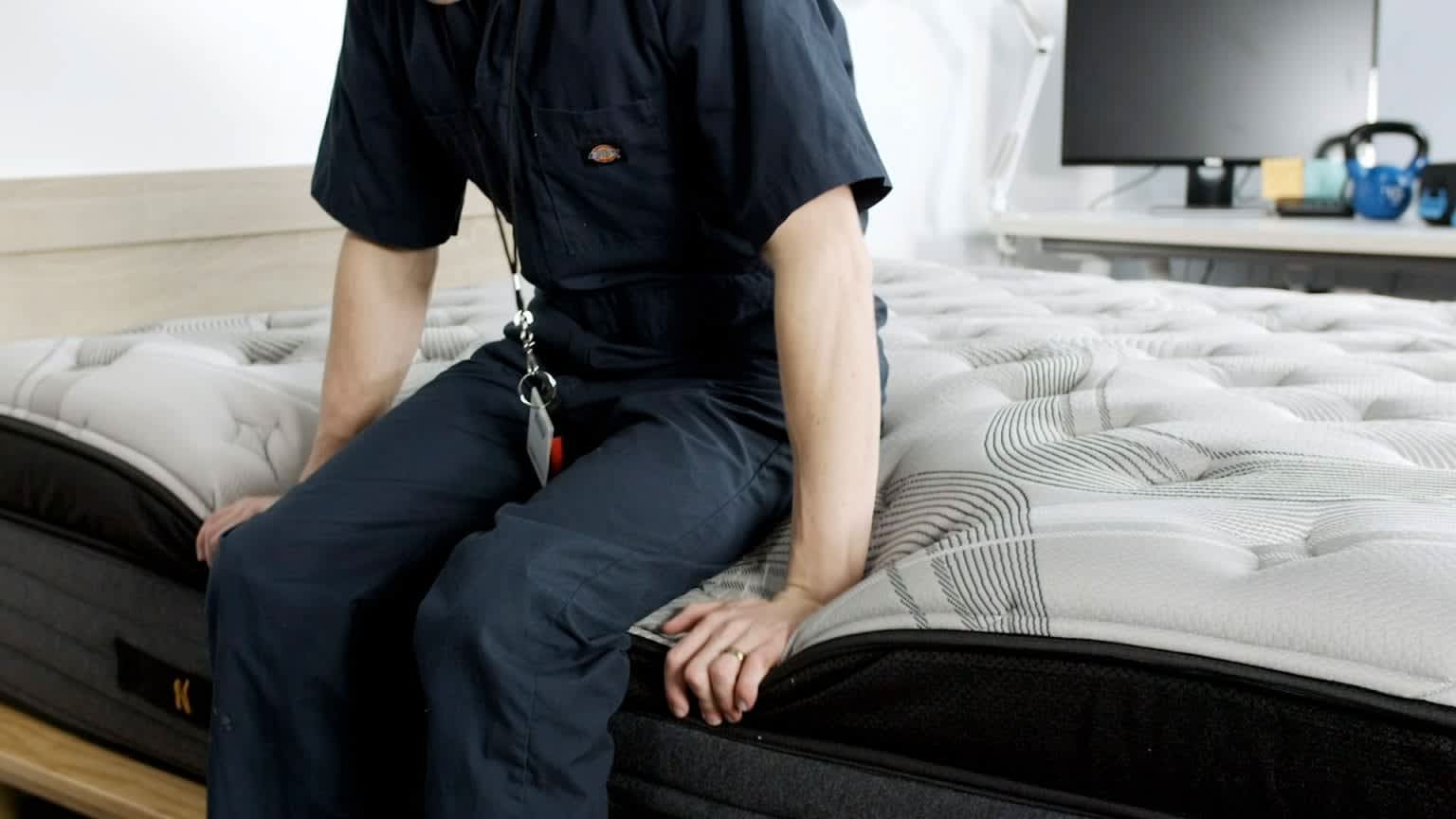
Ease of Movement
The Nolah Evolution 15’s foam layers don’t sink or hug excessively, and the bounce of the coils facilitates movement on the surface. This makes this mattress a solid fit for combination sleepers or anyone who hates feeling stuck in place when lying in bed. With its softer surface, the plush (5) model restricts movement a bit more than the other two. The firm (8) model provided standout ease of movement to all of our sleepers.
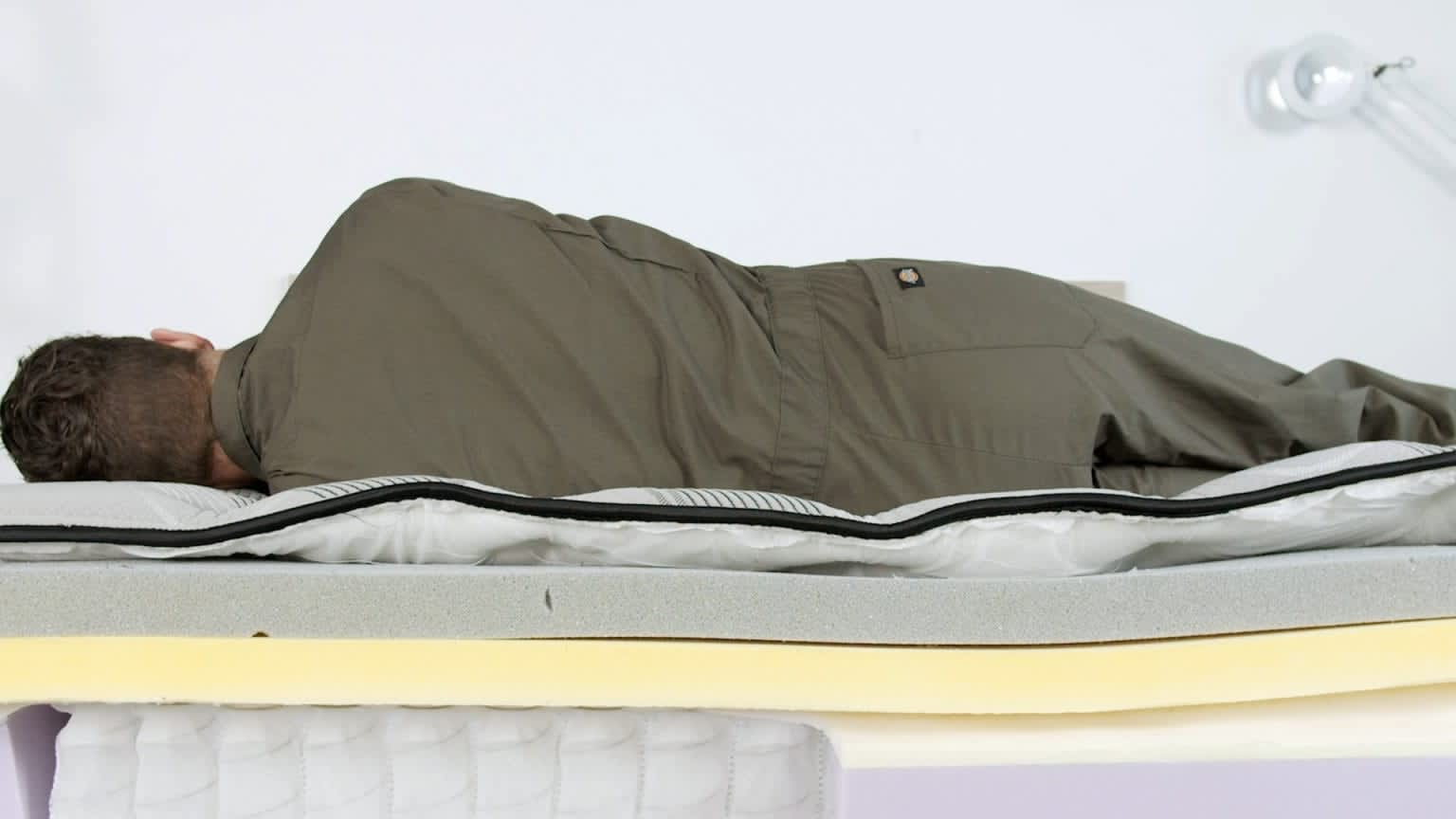
Durability
With a stunning 15-inch profile, seven inches of which are polyfoam found in the comfort layer, the Nolah Evolution 15 is a highly durable mattress. Beneath that are 8-inch coils to give the bed more support. If longevity is your main concern, going with the firmer of the three options may extend the life a bit more. Otherwise, you can generally expect around eight or nine years of comfort.
Full Breakdown
The Nolah Evolution 15 is a quintessential foam hybrid with a thick comfort system that enhances cushioning along your spine, while a zoned support system prevents your body from sagging uncomfortably. Thanks to these features, we recommend the Evolution 15 if you frequently feel pain or stiffness due to uneven spinal alignment.
How It Performed
The Evolution 15 comes in three firmness levels — medium (5), medium firm (6), and firm (8). Our side sleepers weighing up to 230 pounds and back sleepers under 130 pounds enjoyed the softest model’s deep contouring for pressure points. The mid-range model was the most versatile, earning its highest ratings from side sleepers who weigh more than 230 pounds, back sleepers who weigh up to 230 pounds, and stomach sleepers between 130 and 230 pounds. Our back sleepers who weigh at least 130 pounds and stomach sleepers over 230 pounds enjoyed the firmest model’s even support.
Couples who value motion isolation may prefer the softest model, which absorbed most noise and movement transfer in our tests. We recommend the two firmer models for those who prioritize a responsive surface for sex. All three models excelled in temperature regulation, thanks to the breathable coils and cover material.
Construction Breakdown
The Euro-top quilted with polyfoam is followed by two layers of polyfoam. The top polyfoam layer features a graphite infusion meant to conduct and dissipate heat away from the body, and a thinner polyfoam transitional layer acts as a buffer between the foam layers and the coils.
The support core consists of pocketed coils, which are zoned to provide extra support to your midsection and prevent excessive sinkage. Additional coils are zoned along the perimeter of the mattress for extra edge support. The support core rests on a polyfoam base layer to prevent shifting. A quilted cover made from proprietary ArcticTex fiber designed for cooling encases the mattress.
Trial, Shipping, and Warranty
Nolah ships free to customers living in the contiguous U.S. Mattresses come with a 120-night sleep trial, and you can return it anytime after the 30-night break-in period for a full refund. You can also waive the sleep trial for a discount at checkout. Whether or not you opt for the trial, the Evolution 15 is backed by a lifetime warranty.
Read Our Full Nolah Evolution 15 ReviewBest Mattress for Pressure Relief
8.5 /10 Test Lab Score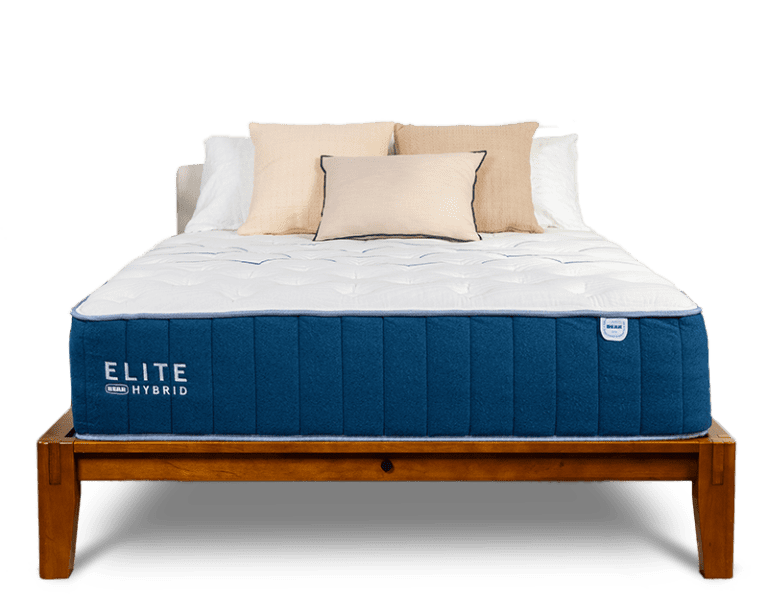
Bear Elite Hybrid
A close-conforming memory foam hybrid offering great pressure relief.
Key Details
- Who It’s Best For: Hot sleepers and people with shoulder, back, or hip pain.
- Feel: Medium (5), firm (8), and medium firm (6).
- What It’s Made Of: Cushy memory foam infused with cooling gel, dense transitional polyfoam, multi-zone pocketed coils in the support core with thicker springs beneath your torso and hips, standard covers with cooling fibers, and and optional upgrade to a Celliant cover.
- What We Don’t Like: Couples may notice motion transfer. The medium model sinks a bit, making it difficult to move on.
Scoring & Reviews
The following ratings show how suitable this mattress is for different sleeping positions and sleeper weights. These scores are determined by how well the mattress supports and relieves pressure for each sleeper type.
In addition to the hands-on feedback from our team, we conduct a number of quantitative tests in our Test Lab. The below ratings are based on the experience of our testers.
SELECT AN ICON TO VIEW DETAILS:
Motion Isolation
The Bear Elite Hybrid shows considerable ability to prevent vibrations from traveling across the surface of the mattress. Its memory foam layer only reacts where weight is directly applied, which helps keep movement from causing ripple effects that spread to the other side of the bed.However, the bounce of the coils can cause some motion transfer, especially on the firm model that has a reduced amount of contouring.
Pressure Relief
The Bear Elite Hybrid offers excellent pressure relief that stems from its comfort system and the zoned, pocketed coils in its support core. In our testing, it was side and back sleepers who tended to get the best pressure relief and support. That said, stomach sleepers liked the firm (8) model that maintained a flat, stable surface with just enough cushioning for the midsection.
Temperature Control
This mattress doesn’t feel overwhelmingly hot, but it also probably shouldn’t be the top choice for hot sleepers. The copper-infused foam makes it slightly cooler than some other memory foam mattresses, but heat can still collect in and around the foam. The risk of overheating is highest on the Luxury Plush model because it has the closest contouring around the skin, which may make it harder for heat around the body to dissipate during the night.
Edge Support
Reinforced edges in the support core help give this mattress a solid rating for edge support. While you’ll notice foam compression around the perimeter, it’s not so significant that you’ll feel like the mattress is giving out beneath you.Of the three different firmness options, edge support is clearly strongest in the firm (8) model and weakest in the one with a firmness level of medium (5).
Ease of Movement
When you need to switch your sleeping position or adjust your body’s alignment on the mattress, you generally won’t encounter much resistance. Sleepers over 230 pounds may find that there’s less ease of movement, especially on the softer models. But in most cases, the springiness from the thick layer of pocketed coils enables relatively easy movement on the surface of the Bear Elite Hybrid.
Durability
The Bear Elite Hybrid Mattress scores above average for durability thanks to its pocketed coils, reinforced perimeter, and memory foam and polyfoam layers. The mattress comes in three firmness levels, and going firmer will typically extend the life of the mattress a bit more. Overall, you should expect around seven to eight years of use.
Full Breakdown
Mattresses with thick foam layers often trap more heat since they adapt so closely to the body, but this isn’t the case for the Bear Elite Hybrid. This mattress is a foam hybrid with a breathable cover, strong internal airflow through its coil system, and cooling technology that help offset the foam’s heat-retaining properties. Hot sleepers on our team felt comfortable throughout testing.
How It Performs
Three firmnesses are available: medium (5), medium firm (6), and firm (8), which appealed to many of our testers. Our testing found the softest model best suited for side and back sleepers weighing less than 130 pounds who enjoyed the extra cushioning. The medium-firm model was the most versatile, appealing to side sleepers weighing at least 130 pounds and back sleepers weighing up to 230 pounds. Our side and back sleepers weighing more than 230 pounds and stomach sleepers who weigh between 130 and 230 pounds appreciated the firmest model’s support.
The Elite Hybrid foam layers absorb most movement to prevent nighttime disruptions for you and your partner when the other person changes positions or tosses and turns. The foam layers also earned the mattress high marks in our pressure relief tests, significantly reducing pressure buildup in our testers’ joints.
Construction Breakdown
The Bear Elite Hybrid contains a comfort layer of memory foam infused with copper, which is intended to reduce heat buildup. Zoned transitional polyfoam offers a firmer feel under heavier areas of the body to prevent excessive sinkage, especially in the midsection.
Pocketed coils reinforce the sleep surface to keep your body on an even plane. The coils rest on a polyfoam base layer for additional stability. Another notable feature of the mattress is its cover made from Celliant Sleep Recover Technology. This proprietary fabric is designed to sleep cool and help your body recover during the night.
Trial, Shipping, and Warranty
Shipping is free throughout the contiguous U.S. Bear’s 120-night sleep trial gives you ample time to test out the mattress, and you’ll also receive a lifetime warranty against structural defects.
Best Mattress for Hot Sleepers
9.1 /10 Test Lab Score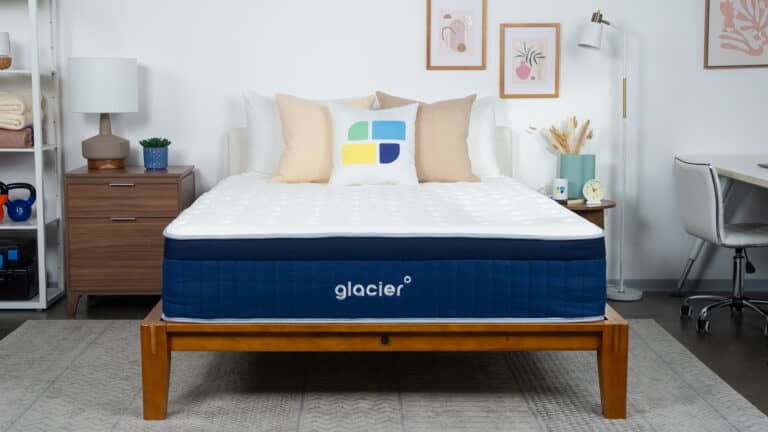
Glacier Summit Hybrid
Affordable hybrid mattress with great pressure relief and cooling.
Key Details
- Who It’s Best For: Side sleepers who over 130 pounds and back sleepers under 230 pounds
- Feel: Medium firm feel with cushioning from the foam layers and a supportive base
- What It’s Made Of: Foam layers encased in a plush Euro-top cover, followed by a pocketed coil support core with reinforced edges.
- What We Don’t Like: Not quite supportive enough for stomach sleepers.
Scoring & Reviews
The following ratings show how suitable this mattress is for different sleeping positions and sleeper weights. These scores are determined by how well the mattress supports and relieves pressure for each sleeper type.
In addition to the hands-on feedback from our team, we conduct a number of quantitative tests in our Test Lab. The below ratings are based on the experience of our testers.
SELECT AN ICON TO VIEW DETAILS:
Motion Isolation
Powered by its memory foam layers, the mattress contours to the body, which helps absorb and isolate vibrations from movement. We found that this made it easier to keep sleeping soundly even when a bed partner moved around on their side of the bed. The high marks in this category help make the Glacier Summit Hybrid a good choice for couples.
Pressure Relief
With its combination of foam layers, this mattress did a better job promoting spinal alignment than the majority of hybrid models. The memory foam lumbar pad properly cushioned the lower back, and the thicker memory foam layer cradled the hips and shoulders to minimize pressure buildup. At the same time, the pocketed coils provided a solid base of support that protected against excess sinkage.
Temperature Control
The mattress has multiple cooling features, including gel-infused and aerated foams and a cooling fabric in the mattress cover. These help counteract the natural tendency of memory foam to retain heat. While people who naturally sleep hot may notice some light heat buildup, most sleepers shouldn’t have an issue.
Edge Support
The Glacier Summit Hybrid Mattress offers much stronger edge support than most other mattresses with memory foam layers. For a mattress with its level of contouring and pressure relief, it exceeded our expectations for edge support. The dependable edge of this mattress is a result of the pocketed coils and their reinforced perimeter. We found this enabled us to sit or sleep near the edge of the bed without any sense of instability or excess sinkage.
Ease of Movement
Although the pocketed coils have a springy feel, most of that is absorbed by the foam layers. As the memory foam conforms to your body, it creates some resistance when you want to adjust your body’s position.While this is unlikely to be a problem for most people, it may bother some combination sleepers and others who regularly shift around in bed.
Durability
The Glacier Summit Hybrid has a robust design with a 5-inch comfort system, plus a pocketed coil support core with reinforced sides. The foams have a medium-firm feel that holds up well against body impressions, and the support system’s high coil count evenly distributes weight to ease wear and tear. We expect this mattress to last at least seven years before needing replacement, which is on par with other hybrid models.
Full Breakdown
If you’re a hot sleeper, a mattress that feels cool and breathable is key to a comfortable night’s rest. The aptly named Glacier Summit Hybrid earned stellar ratings for temperature control during our hands-on tests, with some of our team members saying the mattress offers better breathability and thermoregulation than the majority of foam hybrids we’ve tested. Heat-dissipating fibers woven into the cover, gel and graphite infusions in the comfort system, and coils that promote steady airflow all contribute to the Summit Hybrid’s excellent cooling.
How It Performed
The Glacier Summit Hybrid is medium firm (6). As such, the mattress was popular among most side and back sleepers on our team. Side sleepers of at least 130 pounds and back sleepers weighing up to 230 pounds were particularly impressed, as were combination sleepers who use both positions between 130 and 230 pounds.
During temperature control tests, our thermal sensors registered minimal heat retention on the Summit Hybrid’s surface. We also noticed the cover felt cool to the touch, even after lying on the mattress for several minutes. Other performance areas where the Summit Hybrid earned standout ratings include motion isolation and pressure relief. The reinforced perimeter felt fairly sturdy, as well, so the mattress received favorable ratings for edge support.
Construction Breakdown
The Summit Hybrid’s comfort system begins with a memory foam lumbar pad resting on adaptive polyfoam. This pad is meant to provide extra cushioning to the lower back, and a graphite infusion helps to minimize heat buildup on the surface. Transitional memory foam adds to the plush feel while also pushing back against your weight and creating a buffer between your body and the support core.
Pocketed coils and high-density base foam deliver excellent overall stability for the Summit Hybrid. Thicker coils line the mattress perimeter to make the edges feel secure when you get in and out of bed. A cover woven with cooling, moisture-wicking fibers encases the mattress. At 13 inches, the mattress is on the thicker side but should still be compatible with standard fitted sheets.
Trial, Shipping, and Warranty
Standard ground shipping is free of charge for customers in the contiguous U.S. Glacier’s 365-night sleep trial gives you plenty of time to sleep on the mattress in your own bedroom and decide whether it meets your needs. Those who decide to return the Summit Hybrid during this timeframe receive a full refund, provided the mattress is not damaged and in sanitary condition. If you choose to keep it, your purchase is backed by a lifetime warranty against structural and material defects.
Best Mattress for Combination Sleepers
8.6 /10 Test Lab Score
DLX Premier Hybrid
Versatile hybrid with six differet firmness options.
Key Details
- Who It’s Best For: Most sleepers (depending on firmness level), couples, and hot sleepers.
- Feel: Medium soft (4) model contours closely to cradle your body, the medium firm (6) offers gentle cushioning without too much hug, and the firm (8) feels flat and supportive beneath.
- What It’s Made Of: Viscose fibers quilted to the bottom of the cover, three foam layers, pocketed coils and high-density base foam in the support system.
- What We Don’t Like: Produces a fair amount of off-gassing odor for a few nights after unboxing.
Scoring & Reviews
The following ratings show how suitable this mattress is for different sleeping positions and sleeper weights. These scores are determined by how well the mattress supports and relieves pressure for each sleeper type.
In addition to the hands-on feedback from our team, we conduct a number of quantitative tests in our Test Lab. The below ratings are based on the experience of our testers.
SELECT AN ICON TO VIEW DETAILS:
Motion Isolation
The DLX Premier Hybrid tested pretty well for motion isolation. As a polyfoam hybrid, the foam comfort layers are gonna eat up a fair amount of motion transfer, but the coil support core won’t isolate motion as well as an all-foam base. Also the fact that the comfort layer is all polyfoam instead of memory foam contributes to this. Since this bed has three firmness options, it’s also important to consider that the softer the bed is, the better it will isolate motion.
Pressure Relief
With a hefty 4″ foam comfort layer, the DLX Premier Hybrid did a really good job easing pressure points across the body, particularly in the shoulders and hips. If you like that close-conforming mattress feel, this is a good option for you.
Temperature Control
This bed tested pretty well for temperature neutrality. We found that while the coils in the support core allows for a good amount of airflow, the foam in the comfort layers trap a good amount of body heat throughout the night.
Edge Support
This bed tested very well for edge support, with our testers find very little sinkage when applying weight to the edge of the mattress. This is due to the reinforced perimeter, where the coils on the edge are a bit thicker than those in the middle of the bed.Since this bed has three firmness options, it’s also important to consider that the firmer the bed is, the better edge support it will have.
Ease of Movement
Our testers, particularly the heavier ones, noticed a bit more resistance to move across the bed when performing our ease of movement tests. This comes as no surprise, since the foam comfort layers are pretty thick and conform close to the body.
Durability
The DLX Premier Hybrid mattress has better than average durability thanks to its construction. It has four foam layers (though density levels are just mediocre) and pocketed coil support. You might be able to extend the life of the mattress beyond seven or eight years by choosing the firmer option and going with the 8-inch coils (versus the 6-inch), which should help postpone sinkage.
Full Breakdown
Picking out a mattress with your partner can be difficult if your firmness preferences differ from theirs. DLX Mattress eases this process with the Premier Hybrid, a foam-over-coil mattress available in six firmness configurations. You can opt for a standard medium soft (4), medium firm (6), or firm (8) design. Alternatively, you can arrange for the mattress to be split down the middle with a different firmness level on each side.
How It Performs
Most side sleepers on our testing team enjoyed the deep contouring and cushioning of the medium soft Premier Hybrid. This design hugs your body closely, so side sleepers get the extra padding they need for their shoulders and hips.
That said, some of our side sleepers over 230 pounds needed more support and preferred the medium firm model. This was also true of our back and stomach sleepers weighing up to 230 pounds. If you’re looking for maximum reinforcement, the firm design should meet your needs.
Since the Premier Hybrid contains 4 inches of foam cushioning, the mattress isolates motion better than most competing hybrids. The viscose fiber layer also does a good job of keeping the surface cool — most testers noticed minimal heat retention, even on the softer models.
Construction Breakdown
The Premier Hybrid’s comfort system consists of viscose fiber batting sewn to the bottom of the cover, followed by three foam layers. Each foam layer is progressively firmer and denser, so you get some nice cushioning near the surface and extra pushback to keep your body on an even plane. Pocketed coils in the support core are reinforced with high-density base foam, resulting in excellent overall stability — though the firm model feels sturdiest. Thicker coils along the perimeter help reduce sinkage when you sleep close to the edges or get in and out of bed.
Trial, Shipping, and Warranty
DLX Mattress offers complimentary shipping to customers in the contiguous U.S. The company’s sleep trial lasts 120 nights. Those who decide to keep their mattress also receive a lifetime warranty covering structural defects as long as they retain ownership.
Best Memory Foam Mattress
8.4 /10 Test Lab Score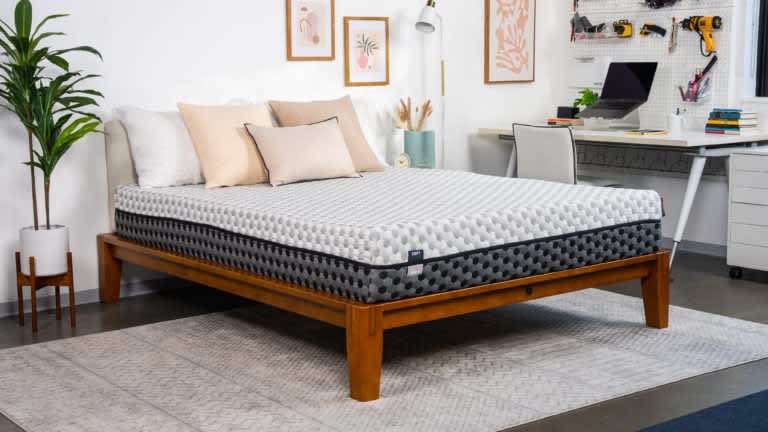
Layla Memory Foam Mattress
The gold standard of dual-sided mattresses with a pleasant memory foam feel.
Key Details
- Who It’s Best For: Couples and people who prefer close contouring, firm support, have fluctuating firmness preferences.
- Feel: One side is medium soft (4) that hugs the body. The other side is firm (7) with minimal contouring.
- What It’s Made Of: Top and bottom sides each feature a comfort system. The medium soft side contains thick layers of memory foam and transitional polyfoam, while the firm side consists of a single memory foam layer. A shared support core of high-density polyfoam rests between the comfort systems.
- What We Don’t Like: Edge support is fairly weak on both sides. Strong off-gassing odor for the first few days after unboxing.
Scoring & Reviews
The following ratings show how suitable this mattress is for different sleeping positions and sleeper weights. These scores are determined by how well the mattress supports and relieves pressure for each sleeper type.
In addition to the hands-on feedback from our team, we conduct a number of quantitative tests in our Test Lab. The below ratings are based on the experience of our testers.
SELECT AN ICON TO VIEW DETAILS:
Motion Isolation
Thanks to the memory foam on both sides, the Layla Memory Foam Mattress effectively reduces the amount of vibration that spreads from one side of the bed to the other.That said, in our testing, it was clear that the softer side provided considerably more motion isolation. For couples who want a plush feel that limits motion transfer, the Layla Mattress is a solid fit.
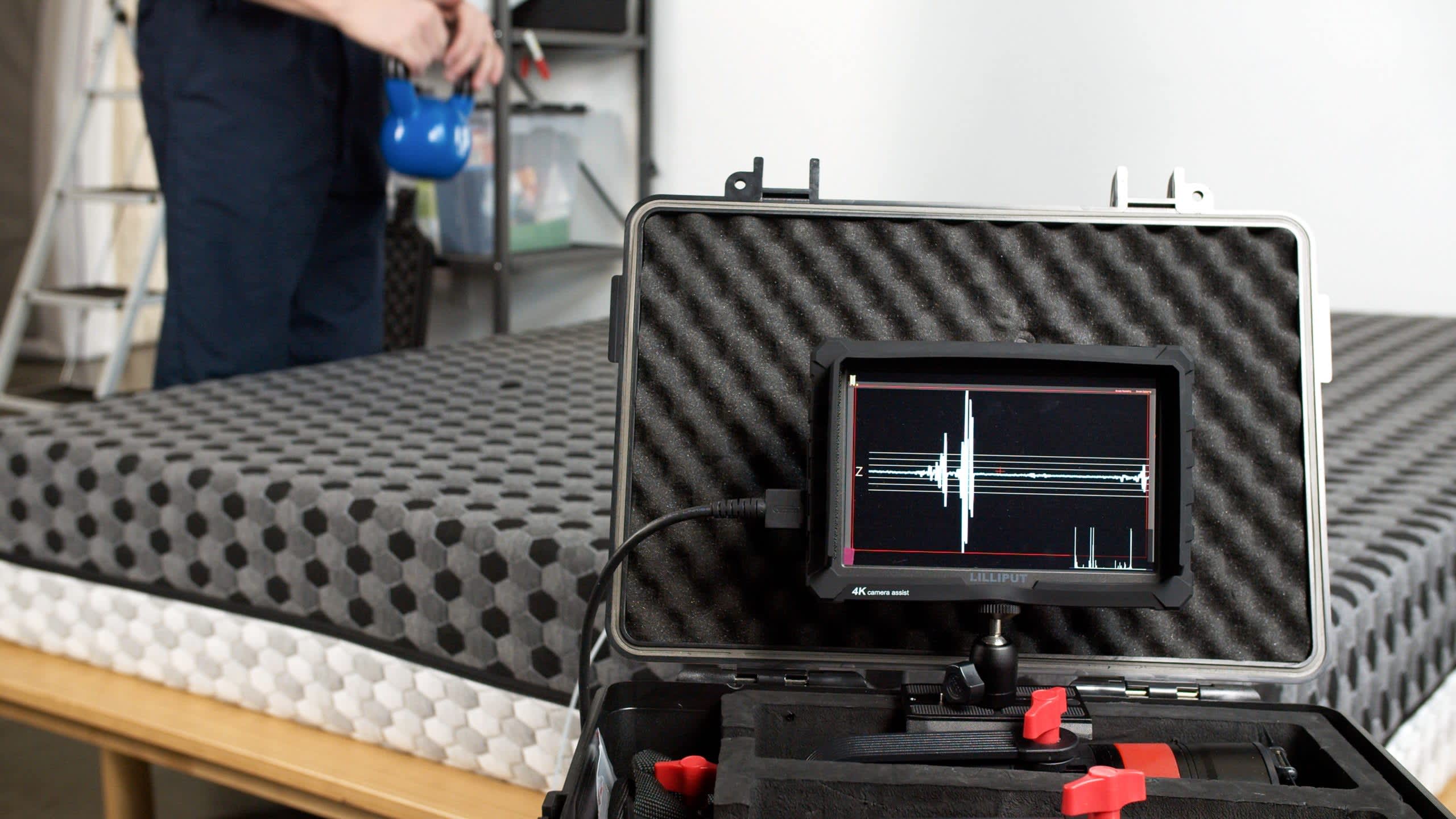
Pressure Relief
Memory foam contours to your hot spots and pain points, giving the Layla Mattress a solid level of pressure relief. However, many sleepers will find that they only get enough support from one of the two sides.For example, the medium soft (4) side is too plush for many sleepers, especially back and stomach sleepers and people over 230 pounds. The firm (7) side is too hard for many side sleepers but can deliver great support to many back sleepers.
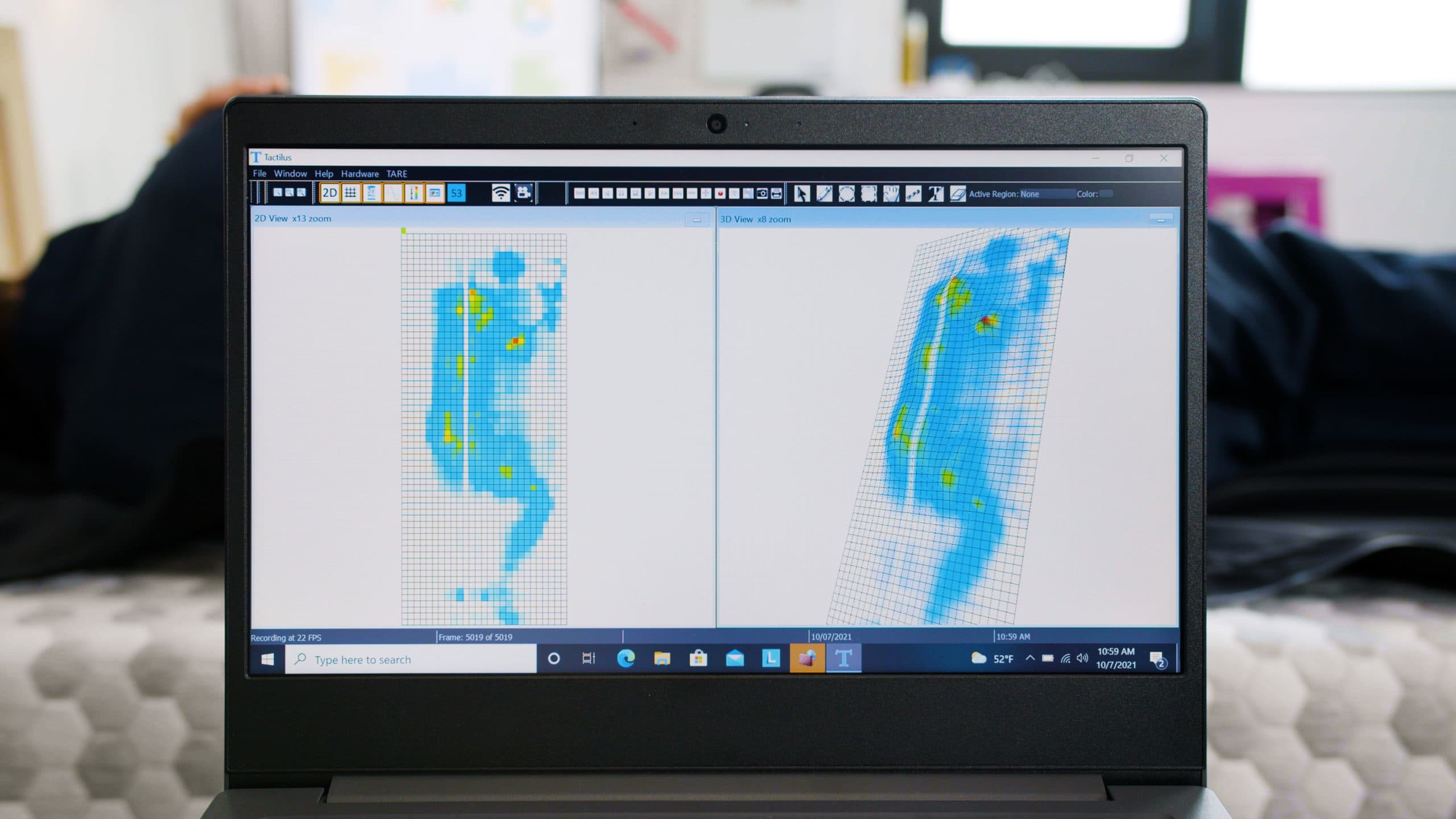
Temperature Control
Heat retention is noticeable but not excessive on the Layla Memory Foam Mattress. With a thinner layer of memory foam, the firm (7) side tends to resist heat buildup far better than the medium soft (4) side.Layla incorporates cooling features like copper-infused and aerated foams to try to enhance temperature regulation, but this mattress may still be too warm for hot sleepers.
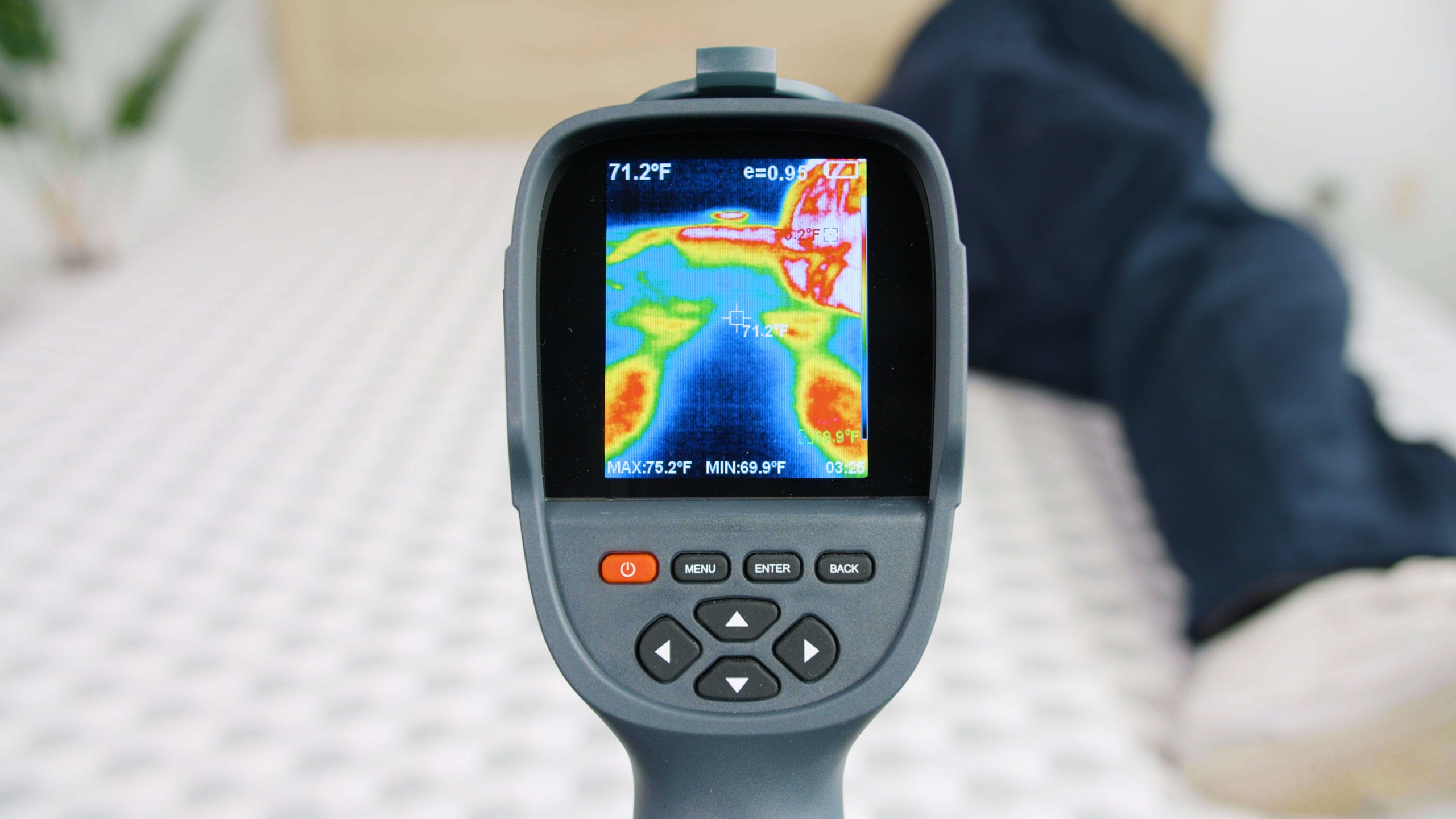
Edge Support
Edge support is one of the weak points of the Layla Mattress. While it doesn’t feel totally unstable, the foam layers are considerably weaker around the edge of the mattress. As you would suspect, there’s more sinkage around the perimeter on the medium soft (4) side.
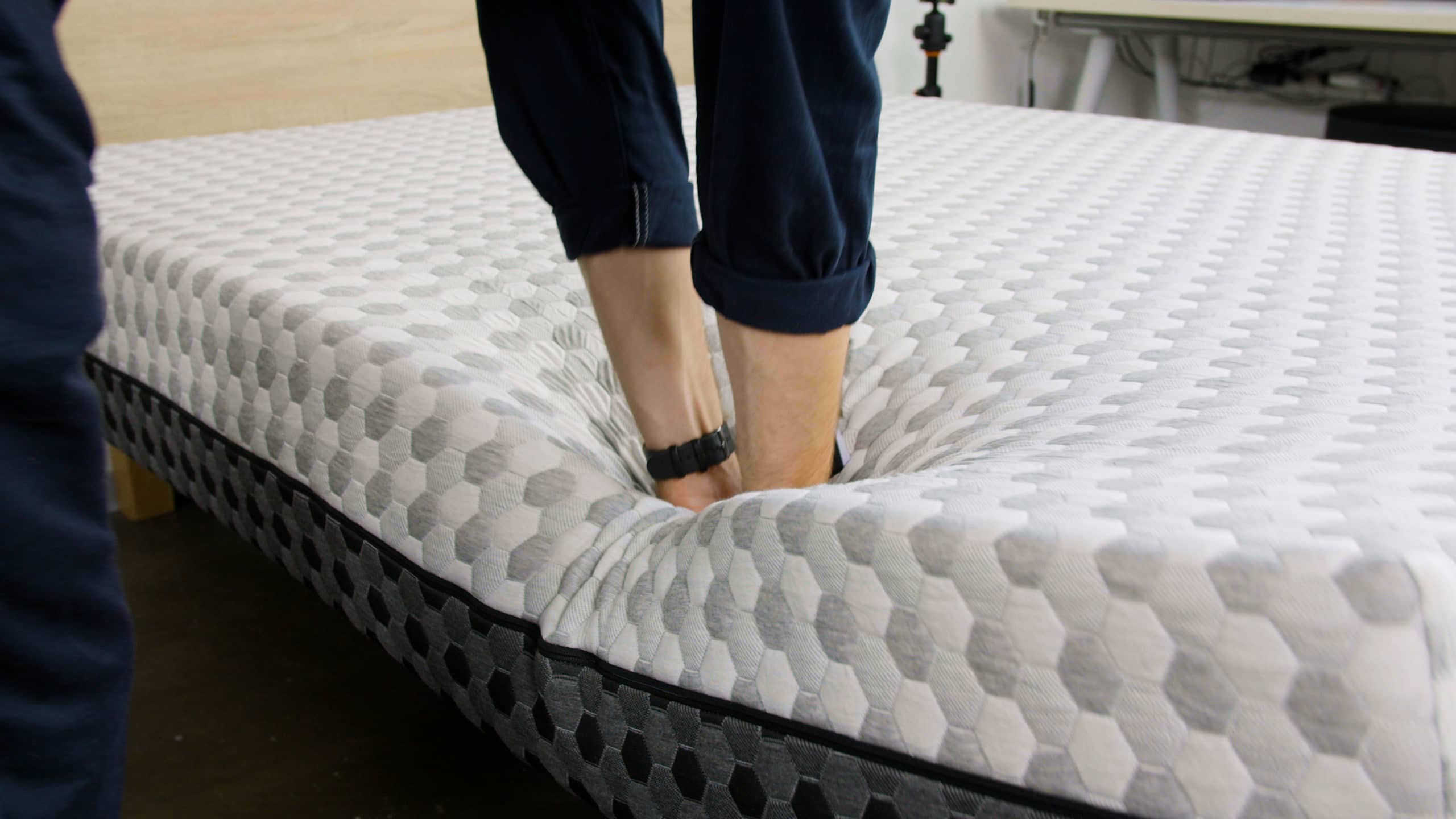
Ease of Movement
The conforming feel of memory foam can impede movement – something all of our testers noticed. With the additional plushness on the medium soft (4) side, it was a struggle to switch sleeping positions. Movement was quite a bit easier on the firm (7) side.For most people, reduced ease of movement isn’t reason enough to pick a different mattress. But it may be a serious issue for combination sleepers or anyone who frequently turns over or adjusts their body’s positioning in bed.

Durability
For an all-foam bed, the Layla Memory Foam mattress has decent durability, but without any coils to add support, it likely won’t last beyond the typcial six- or seven-year mattress lifespan. The construction includes a 3.5 PCF memory foam (which is considered medium density), plus two inches of stronger polyfoam. Sleepers have the option to sleep on the soft or firm side, which can make it more versatile.
Full Breakdown
The Layla Mattress is a versatile model featuring a reversible design with two distinct feels. Sleepers can choose between the closely contouring medium soft (4) side or a more supportive firm (7) side.
How It Performed
Thanks to the two different feels, the Layla performed well across many sleeping positions and weight groups. Our testing team found the softer surface great for side sleepers, those under 130 pounds, and people with pain in their joints. Meanwhile, the firmer side ranked highly among back and stomach sleepers on our team, especially those between 130 and 230 pounds.
Foam mattresses are prone to heat retention, but the Layla slept quite cool compared to many other foam models we’ve evaluated with heat-mapping tests. Both sides ranked above average in temperature regulation, but the firm side performed particularly well in this area. We attribute this to the firmer feel and less sinkage, which limits heat-trapping. Copper and gel infusions are also designed to keep the foams cooler.
Couples may appreciate the softer side for its strong motion isolation. We noticed that the thicker comfort layers on this side absorbed most movement transfer, reducing sleep disruptions for co-sleepers.
Construction Breakdown
The softer side starts with a 3-inch layer of copper- and gel-infused memory foam. This layer deeply contoured to the body during our tests, which relieved pressure buildup in the joints and lower back. Underneath is a 2-inch polyfoam transitional layer that is zoned to support the midsection and prevent excessive sinkage. We found this layer also evenly distributed weight to help you maintain healthy spinal alignment.
On the firm side is a thinner comfort layer made from the same copper- and gel-infused memory foam. The shared support core is composed of a 4.5-inch layer of high-density polyfoam. This layer helps prevent you from sinking too deeply into the mattress. A cover made from a stretch blend of polyester, rayon, viscose, and poly-lycra encases the mattress.
Trial, Shipping, and Warranty
Layla ships free to the contiguous U.S., and mattress purchases are backed by a 120-night sleep trial. Purchases also come with a lifetime warranty covering structural defects.
Watch Video: We Tested the Most Comfortable Mattresses of 2025 – Here Are Our Favorites
Watch the video below to get a more in-depth look at our top picks for most comfortable mattress.
Which Mattress Types Are Most Comfortable?
There are a huge number of mattresses available today, making it difficult to know which one is right for you. Before settling on a model, it’s good to understand mattress constructions so that you can choose the mattress type that’s most comfortable for your individual needs, and steer clear of those that don’t suit your preferences.
A mattress’ type is determined by two main parts of its construction:
- The comfort system: the top layers of the bed that you sleep on and feel directly
- The support core: the base section of the bed that supports your body as you sleep
“Think of your mattress layers as a coordinated system,” says Dr. Dustin Cotliar, M.D., MPH. “The comfort layers contour to your body’s unique shape, while the support core prevents excessive sinking. This balance is important for maintaining proper spinal position throughout the night.”
Foam
If you’re tired of tossing and turning to get comfortable, or you wake up every time your partner moves in bed, then foam beds are for you.
Foam mattresses have support cores and comfort systems made entirely from foam. You can find models with polyfoam, memory foam, or layers of both. They’re known for providing excellent pressure relief and motion isolation. Foam mattresses tend to retain more heat than other mattress types and they can have a chemical-like smell at first.
When you lie on a foam bed, the surface adapts to your body’s shape to cushion impact zones and absorb movement. Some softer foam beds can give you a hugging sensation and the feeling that you’re sleeping “in” rather than “on” the mattress.
Hybrid
If you want a blend of strong support and cushioning, a variety of options, or you want to find the perfect combination for your needs, then you’ll likely find what you’re looking for in a hybrid bed.
Hybrids have some of the most versatile mattress constructions. Typically, a hybrid has a support core made from pocketed coils. Some hybrids have zones built into their cores to target support for different areas of the body, or their edges are reinforced with stronger coils for more structure.
Hybrid comfort systems vary widely and can feature a number of materials including polyfoam, memory foam, latex, wool, and microfiber. Because there are so many material combinations, you can find hybrids that fit nearly every sleeper’s firmness and cushioning preferences. They often sleep cool and generally have better edge support than foam mattresses. Since they require multiple material types and have complex constructions, hybrids often cost more than foam or basic innerspring mattresses.
Innerspring
If you want a really supportive and bouncy bed without too much cushioning or frills, then you’re probably looking for an innerspring bed.
Innerspring is a term that’s often used interchangeably with hybrid, though the two differ when it comes to their top layers. Like hybrids, traditional innerspring mattresses have coil support cores that provide pushback and responsiveness. Basic innersprings may have a thin layer on top of the support core to prevent you from feeling the springs. More complex constructions may have pillow-tops or Euro-tops that add more cushioning to enhance comfort or pressure relief.
Innersprings with simple constructions can be quite affordable, while those with multi-layer comfort systems may cost significantly more. Hot sleepers generally like how well innersprings regulate temperature, and those who like a traditionally bouncy sleep surface prefer innersprings over foam mattresses.
Latex
If you’re looking for strong, well-rounded performance and a bouncier feel that doesn’t hug too close to your body, then latex beds are right up your alley.
While shopping, you may see all-latex beds that have both comfort systems and support cores made from latex, as well as hybrids that feature latex in their comfort systems. Latex is a naturally springy material, and beds that contain it often feel bouncy and resilient. It doesn’t retain heat and sleeps cooler than foam and other pressure-relieving materials.
The type of tree that produces rubber also makes latex. It can be sustainably grown and harvested and is a worthwhile choice for people looking for an environmentally friendly option. Because it’s a natural material, latex can be fairly expensive. However, it’s quite durable, and many latex mattresses last longer than other mattress types.
Airbed
If you’re not sure what you need from a bed, your needs change often, or you share a bed with your partner and can’t agree on what feels right, then airbeds should be on your radar.
Airbeds have a unique support core that inflates and deflates with a remote-controlled motor. This allows you to choose your mattress’ firmness level and change it whenever you want. They’re highly versatile and are excellent for couples with different preferences, as each partner can choose a firmness for their own side of the bed.
Most airbeds have some type of cover system over top of the air chambers. Materials can include foam, latex, microfiber, and wool. They generally sleep cool and are available with a wide range of features. The catch with airbeds is usually noise and cost – they’re far more expensive than other mattress types and the motors can be loud.
How to Choose a Comfortable Mattress
We’ll make mattress shopping easier by helping you learn what you need from a bed before you start your research.
Choosing the Right Firmness for You
We measure mattress firmness on a scale from 1 to 10. Lower numbers represent softer mattresses while higher numbers are firmer. The right firmness level is largely dependent on your weight, preferences, and favorite sleeping position. A firmness level that’s appropriate for each of these will feel both supportive and comfortable.
“While most people tend to find comfort in the medium-firm range (around 5-7 on the firmness scale), individual needs vary significantly,” says Dr. Cotliar. “Some sleepers require softer or firmer surfaces based on their body type, sleeping position, and any existing musculoskeletal conditions.”
Sleeping Position and Body Type
Side, back, and stomach sleepers typically prefer different firmness levels from one another, though there is some overlap. Stomach sleepers need a firmer (6 to 9), even sleep surface that doesn’t allow their midsections to sink into a mattress. Back sleepers most often like a medium (5) to firm (8) mattress that has both cushioning and strong support. Side sleepers prefer a soft (3) to medium firm (6) mattress that prevents pressure points from building beneath the hips and shoulders.
Your body weight also affects which firmness level you should pick. Sleepers who weigh more than 230 pounds typically need stronger support to keep their spines evenly aligned, while sleepers under 130 need a softer surface. Sleepers between 130 and 230 pounds often do best on a mid-range firmness level.
We’ve put together a quick breakdown of our recommendations for firmness levels based on your body weight and sleeping position here:
| Weight | Side Sleepers | Back Sleepers | Stomach Sleepers |
|---|---|---|---|
| Less than 130 lbs. | Soft (3) to Medium (5) | Soft (3) to Medium (5) | Medium Soft (4) to Medium Firm (6) |
| 130 to 230 lbs. | Medium Soft (4) to Medium (5) | Medium (5) to Firm (7) | Medium (5) to Firm (7) |
| More than 230 lbs. | Medium Firm (6) to Firm (7) | Firm (7, 8) to Extra Firm (9) | Firm (7, 8) to Extra Firm (9) |
Spinal Alignment
Improper spinal alignment can lead to acute and chronic pain, so it’s important to choose a mattress that keeps your spine evenly supported from head to toe. To find a mattress with enough spinal support, look for one that’s the right firmness level for your weight and sleeping position.
Think of it this way: When you’re laying in bed, you should be able to imagine a straight, even line over your spine from your head to your toes. Any dips or curves in your spine can result in discomfort.
Pressure Relief
Pressure relief often means the difference between a full night’s sleep and tossing and turning through the night to get comfortable. Some sleepers feel intense pressure beneath their hips, shoulders, lower back, or joints. Health conditions like arthritis or fibromyalgia can cause pressure point discomfort, but you can also experience pressure points if you sleep on a mattress that doesn’t have enough cushioning. To combat this, choose a mattress with an appropriate firmness level and materials that contour alongside your body while evenly dispersing your weight, like foam or latex.
Quality and Durability
When a mattress begins to wear out, it can start to lose support. It’s important to replace your mattress when it shows signs of wear, but you can get a few extra years by buying a bed made with high-quality materials. A well-made mattress also typically gives you better sleep night after night than one with low-end materials.
Size and Height
Make sure to purchase a mattress that’s the right size for your needs, especially if you sleep with a partner. Your bed’s height can make a difference in overall comfort too, particularly if you have mobility limitations and have a tough time getting in and out of bed.
Breathability
If you’re a hot sleeper or live somewhere with a warm climate, a breathable bed can make a huge difference. Hybrid and latex models tend to sleep cooler than foam mattresses do because they let air move freely through the mattress rather than trapping it. If you prefer the feel of foam, look for models with gel or copper infusions designed to decrease heat buildup.
Dr. Cotliar notes our sleep cycles are closely tied to body temperature regulation. “The body naturally needs to cool down to initiate and maintain deep sleep phases. Sleeping on a surface that traps too much heat can disrupt this process, potentially affecting both how quickly you fall asleep and the quality of your sleep throughout the night.”
Do You Share a Bed?
Edge support and motion isolation are two of the most important factors for people who share a bed, whether with dogs, kids, or a partner. Strong perimeter support allows you to spread out and sleep comfortably up to the edge of the bed, while motion isolation lets you move on your side of the bed without disturbing your partner.
Sleep Trials, Returns, and Warranties
Many mattress manufacturers allow you to return your bed for a different firmness level or a refund if you do so within the company’s trial window. A 90-day trial period is often seen as the industry standard, but some companies offer longer trial windows. Some charge for returns, while others include free returns with the trial. Warranties may be pro-rated or cover a mattress entirely if it has a defect. Reading over the fine print and checking existing customer reviews can help you get a realistic sense of how well a company’s policies are put into practice.
If comfort is your top priority, look for mattress manufacturers with flexible policies that let you swap mattress models or materials until you find the right one.
Tips for Making Your Bed More Comfortable
Invest in Cozy Bedding
Make sure you have the right bedding for your needs, since your pillows and sheets are arguably just as important as your mattress when it comes to comfort. Even if you have the perfect mattress, scratchy sheets or a flat pillow can make your bed uncomfortable and be distracting while you sleep.
Sheets come in a variety of different options, so it’s important to find a set that feels comfortable on your skin and keeps you at the right temperature as you sleep. Pay attention to things like material, weave, and breathability.
Pillows support your head and neck throughout the night, so it’s important to find one that sets you up to sleep comfortably. Side, back, and stomach sleepers all need their necks held at different heights to maintain spinal alignment and get enough support.
“Even with an optimal mattress, using the wrong pillow height can strain the spinal column,” says Dr. Cotliar. “When your head and neck aren’t properly supported, it creates a domino effect of misalignment that can extend all the way down to your lower back.”
Add a Mattress Topper or Pad
If your mattress doesn’t feel quite right, you can change your bed’s feel easily and affordably by adding a mattress topper or pad. Toppers typically measure 2 to 4 inches thick and can be made out of a variety of materials that each have distinct firmness levels and feels.
Pads are thinner, usually 1 to 2 inches thick, and designed to protect your mattress while slightly altering its feel. Both pads and toppers can help extend your bed’s lifespan and make your mattress feel softer or firmer.
Care for Your Mattress Properly
Treating your mattress with care can go a long way toward increasing your comfort long term. Some models come with washable covers, but you can also use a protector to safeguard against stains and fabric wear and tear. While newer mattresses aren’t typically designed to be flipped, you can usually rotate them 180 degrees to help prevent premature sagging.
How We Test: Your Comfort Is Our Science
Our industry-leading product testing team cares deeply about improving your sleep. Having a holistic understanding of a mattress’s role as part of a sleep system is paramount to our testing process. Since a bed’s comfort and feel depend largely on body weight and sleeping position, our testing team represents a wide range of body types, sleep positions, and comfort preferences.
In our Seattle-based Test Lab, we use an objective, hands-on process to evaluate mattresses across performance categories. The following are the key guidelines that inform our performance ratings. Our ultimate goal is to ensure you have all the information you need to make the best purchase decision for you.
Construction analysis: We begin testing each mattress by analyzing its design and making note firmness, height, individual layer composition, and sticker price. This allows us to evaluate qualities like support, durability, and value.
Product testing: Firsthand testing is crucial to our evaluation and ratings system. We use a wide range of tools and technology to test mattresses in six performance categories: motion isolation, pressure relief, temperature control, ease of movement, edge support, and odor potential.
Field testing: In addition to lab-based tests, we base our ratings on feedback from field testers who use the mattresses in their own homes. They spend several weeks collecting data — this gives us insights into how the mattress performs night after night for an extended period.
User testing: We curate feedback verified owners have provided in surveys, sleep stories, and product reviews. This helps us evaluate our initial findings and, if needed, tweak our ratings to reflect real-world experiences.
How We Determine Our Overall Scores


To determine a mattress’s overall score, we assign weighted percentages to performance categories based on how important they are to the individual sleep experience. For instance, areas like pressure relief and temperature control tend to matter more to people than something like off-gassing, and because more people sleep on their side and back than on their stomach, we weigh those positions more heavily.
Performance Categories
Motion Isolation
This criteria alludes to the amount of motion a mattress absorbs when a sleeper moves on the surface. We use two testers lying side by side to evaluate motion isolation, who each feel for transfer while the other person moves on the mattress.
Temperature Control
To determine how well a mattress regulates temperature, we perform temperature tests and look closely at its materials and construction. Many mattresses are designed with cooling components meant to reduce heat retention.
Pressure Relief
A bed with strong pressure relief excels at preventing pressure from building up in areas like the shoulders and hips. Beds with even contouring and weight distribution are top performers when it comes to pressure relief.
Off-Gassing
A mattress in a box may release unpleasant chemical odors for a short period after you’ve unboxed it. The initial smell may be strong but typically fades within 2 or 3 days.
Ease of Movement
This criteria reflects how easily a sleeper can move across a bed’s surface. Responsive surfaces made of latex typically perform better than foam surfaces, which can inhibit movement.
Edge Support
We perform sit tests along a bed’s perimeter to measure how well the edges push back against weight. Mattresses with strong edge support have minimal sagging when sleepers sit on or lie close to the perimeter.
Dive Deeper – Mattress Guides by Feel
If you’re looking to expand your search beyond the beds featured here, you can narrow down your search by reading our recommendations sorted by mattress feel.
Best Mattress by Firmness Level
Frequently Asked Questions
What is the most comfortable mattress for back pain?
The most comfortable mattress for back pain is one that keeps your spine completely supported from head to toe. If your mattress isn’t supportive enough it can cause your spine to bend, resulting in pain. In addition to strong support, the most comfortable mattress for back pain will also have enough cushioning to prevent stress and pressure in your lower back.
What is the most comfortable mattress for side sleepers?
Most side sleepers prefer a mattress on the softer side that has plenty of pressure relief. Materials like foam and latex contour with your body to absorb impact and decrease pressure build up. Zoned support systems are also excellent for side sleepers, as they increase and decrease pushback on certain parts of your body so that sleepers get enough support without having to use an uncomfortably firm mattress.
What makes a mattress comfortable?
What makes a mattress comfortable is largely related to personal preference, but generally speaking, the most critical factor is getting enough support for your body weight and sleeping position. Once you have a baseline of support, you can consider what else will make your mattress comfortable for you – whether that’s temperature control, pressure relief, or extra support at the edges.
How can you make your mattress more comfortable?
You can make your mattress more comfortable by using a mattress pad that changes the firmness level, by adding cooling features, or by simply buying new bedding. In order to make your sleep environment better, first identify what is making it uncomfortable for you. You can alter a mattress’ feel easily by adding a topper that improves whatever your bed is lacking, whether that’s spinal support, pressure relief, or motion isolation.
How much does a mattress cost?
Mattress costs differ depending on the type and size you choose but typically budget mattresses average $250 to $1,000, mid-range models cost $500 to $1,500, and high-end luxury beds run between $1,200 and $3,000 or more. Innerspring and foam mattresses are typically more affordable than latex and hybrid mattresses.

Still have questions? Ask our community!
Join our Sleep Care Community — a trusted hub of product specialists, sleep health professionals, and people just like you. Whether you’re searching for the perfect mattress or need expert sleep advice, we’ve got you covered. Get personalized guidance from the experts who know sleep best.

